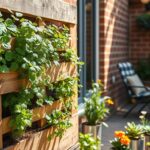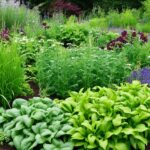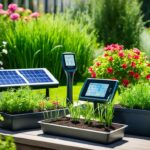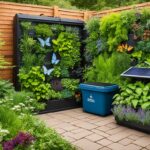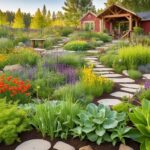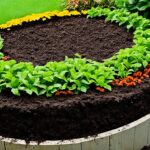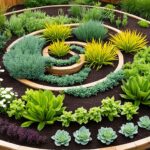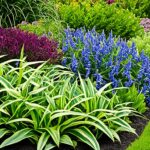Sustainable Gardening
DIY Garden Projects for Small Spaces: Upcycling Ideas to Maximize Your Garden
Feeling stuck with your small outdoor area? Get ready for a big change! This article will show you how to turn a tiny space into a lush garden. You’ll learn to use everyday items as planters and build raised beds on a budget. These ideas will help you make the most of your small garden and create a beautiful spot to relax.
Key Takeaways
- Discover upcycling ideas to turn everyday items into unique planters for your small space garden
- Explore vertical gardening solutions to maximize your limited square footage
- Learn how to transform a balcony or patio into a thriving urban oasis
- Create affordable raised bed gardens using reclaimed materials
- Ignite your imagination with enchanting fairy garden projects
- Grow your own herb garden, even in the smallest of indoor or outdoor spaces
- Decorate your garden on a budget with DIY upcycled projects
Feeling inspired yet? Get ready to unleash your creativity and transform your small space into a magnificent garden oasis. But first, let’s tackle the question that’s likely on your mind: How can I create a beautiful, functional garden in a limited space? The answers are about to unfold, so keep reading!
Unleash Your Creativity with DIY Container Gardens
Take your small-space gardening to the next level with DIY container gardens. Turn everyday items like buckets, suitcases, and old bookshelves into unique planters. These budget-friendly options add charm to your outdoor space.
Repurposing Everyday Items as Planters
Get creative and turn household items into beautiful DIY container gardens. Use vintage suitcases, wooden crates, or galvanized buckets for a unique look. The possibilities are endless, so let your imagination soar!
Creative Vertical Gardening Solutions
Want to make the most of your limited space? Try vertical gardening. Hang planters, use tiered stands, or build a vertical garden with salvaged materials. These ideas let you grow flowers, herbs, and small vegetables without taking up much space.
Enjoy the beauty of small space gardening with these DIY container garden ideas. Let your creativity shine and watch your garden come alive with personality.
Transform Your Balcony into an Urban Oasis
Make the most of your balcony and turn it into a green, welcoming spot with these balcony gardening tips. You can make a cozy outdoor area that shows off your style and love for urban gardening, even with a small patio or balcony.
Begin by looking into ways to save space for your small space gardening needs. Use hanging baskets full of flowing flowers, or put up vertical planters to make your balcony garden look interesting. Small raised beds are great too. They look good and are perfect for your favorite plants.
Pick plants for your balcony that do well in pots and can handle city life. You can choose from beautiful vines, bright annuals, and tough perennials. Plan your garden to look good together and show off your style.
“Transforming my balcony into a little urban oasis has been truly rewarding. It’s a sanctuary where I can reconnect with nature, even in the heart of the city.”
With some creativity and DIY skills, your balcony can become a peaceful spot that feels like a different world. Enjoy the beauty of balcony gardening and see your urban oasis grow into a lively, useful, and beautiful place.
Maximize Your Patio with Raised Bed Gardens
If you’re short on garden space but love gardening, raised bed gardens are ideal for your patio or small area. These beds improve soil quality and make gardening easier. They’re great for raised bed gardening and patio gardening fans.
Upcycling Materials for Affordable Raised Beds
Creating raised beds with upcycled materials is a smart way to save money and be creative. Use old wood, bricks, or big containers to make upcycled raised beds for your small space gardening needs.
- Transform reclaimed wood into custom-sized raised beds
- Upcycle bricks, stones, or cinder blocks to create sturdy, long-lasting frames
- Repurpose large containers, such as barrels or galvanized tubs, into mobile raised gardens
Be creative with materials to design your own unique raised bed gardens. This way, you can make the most of your patio space and show off your style. Enjoy the fun of DIY gardening and turn your small area into a lush, productive spot.
DIY garden projects for small spaces
Creating a garden in a small outdoor area can seem tough, but with the right DIY projects, you can make even the tiniest spots a lush oasis. This section offers inspiring ideas for making the most of your small garden space. From creative container gardening to innovative vertical solutions, there’s something for everyone.
Embrace the Power of Container Gardening
Containers are perfect for gardeners with limited space. Use items like old buckets, wooden crates, or hanging baskets to create unique planters. This way, you can add personality to your DIY garden projects beyond the usual flower pot.
Vertical Gardening for the Space-Savvy
If you’re short on floor space, consider vertical gardening. This method lets you grow plants, herbs, and small vegetables in a small area. Build DIY trellises, wall-mounted planters, or tiered stands to use your small space gardening space wisely.
Whether you’re working with a balcony, patio, or windowsill, these DIY projects for urban gardening and container gardening can help you bring your green dreams to life. No matter the size of your outdoor area, these ideas offer endless possibilities.
| DIY Garden Project | Benefits | Difficulty Level |
|---|---|---|
| Upcycled Container Garden | Adds charm and personality, maximizes available space | Easy |
| Vertical Herb Garden | Saves floor space, provides easy access to fresh herbs | Moderate |
| Tiered Planter Stand | Enhances visual interest, allows for diverse plantings | Intermediate |
Fairy Garden Magic: Enchanting Miniature Worlds
Unleash your creativity and turn your small space into a fairy garden oasis! These gardens are great for gardeners who love the whimsical and magical. They let you add magic to tiny outdoor areas, like balconies or patios.
Whimsical Fairy Garden Ideas for Small Spaces
Fairy gardens need imagination and creativity. Use items like teacups, birdhouses, and old shoes as planters. Add stones, twigs, and moss for a woodland feel. Include fairy houses and other fun accessories to make it magical.
- Upcycle everyday items into unique fairy garden containers
- Use natural elements like rocks, sticks, and dried flowers for a rustic touch
- Include whimsical fairy statues, miniature furniture, and other enchanting accents
With creativity and a bit of fairy dust, you can make a magical world in your garden. Enjoy making your own fairy garden and let your imagination run wild!
Herb Gardens: Spice Up Your Indoor and Outdoor Spaces
Take your cooking to the next level with a vibrant herb garden, even in small spaces. Whether you have a balcony, patio, or a tiny indoor spot, you can grow a lush herb garden. This will add fresh, homegrown flavors to your meals.
Discover DIY herb garden projects that make the most of your space. Use tiered planters and vertical walls to grow many herbs in a small area. This way, you can have a small space gardening spot right at your fingertips.
When picking herbs for your herb gardens, think about the climate, sunlight, and what you like to cook. Great choices include basil, rosemary, thyme, mint, and parsley. These herbs grow well in different conditions and add flavor to many dishes.
| Herb | Ideal Conditions | Culinary Uses |
|---|---|---|
| Basil | Full sun, well-drained soil | Pesto, tomato dishes, salads |
| Rosemary | Full sun, dry, well-drained soil | Roasted meats, potatoes, focaccia |
| Thyme | Full sun, well-drained soil | Soups, stews, sauces, marinades |
| Mint | Partial shade, moist soil | Teas, cocktails, salads, desserts |
| Parsley | Full sun to partial shade, well-drained soil | Garnishes, sauces, salads, soups |
Enjoy the fun of DIY garden projects. Turn your indoor or outdoor area into a lush herb oasis. This will make your cooking adventures better and add natural beauty to your home.
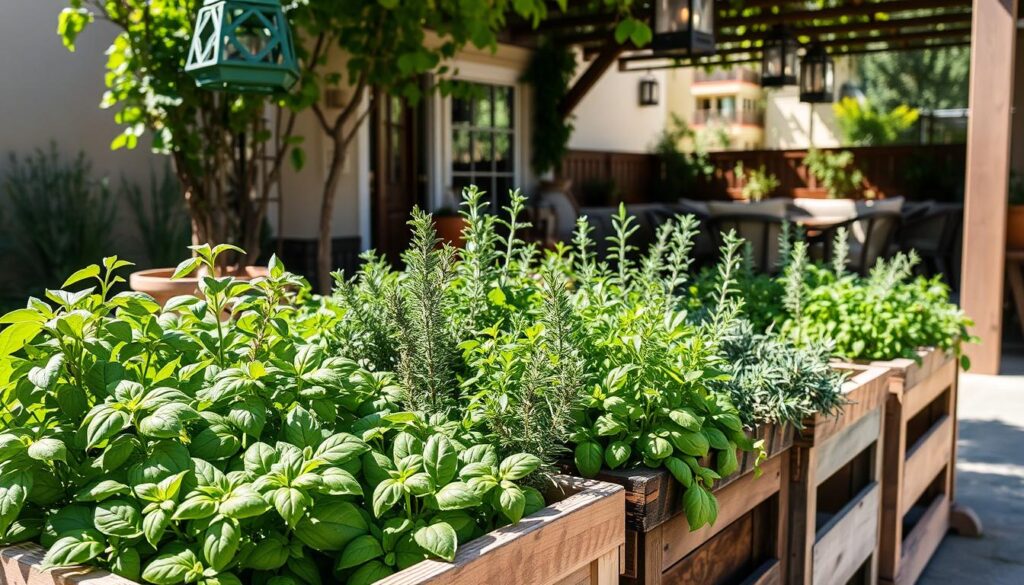
Garden Decor on a Budget: Upcycling Ideas
Don’t think you need to spend a lot to make your small-space garden look great. Get creative and turn everyday items into beautiful garden decorations. Use things you might throw away to add a personal touch and interest to your garden without spending a lot.
Painted Rock Garden Markers
Show off your artistic skills by making your own garden markers with rocks from your yard. Paint them with bright designs or inspiring. It’s an easy and cheap way to make your garden decor stand out. Place them in your plant beds or along paths for a unique, DIY look.
Rustic Garden Decor from Natural Materials
Use nature to create beautiful garden decor. Turn old wood, pinecones, driftwood, or dried flowers into unique decorations. These DIY garden projects with natural materials will add warmth and rustic beauty to your garden.
| Upcycled Item | Repurposed Garden Decor |
|---|---|
| Old Ladder | Vertical Plant Display |
| Discarded Buckets | Colorful Planter Boxes |
| Vintage Birdhouses | Whimsical Accent Pieces |
“Upcycling allows you to create beautiful, one-of-a-kind garden decor that reflects your personal style and values.”
By using upcycling, you can give old items a new life. Turn your small-space garden into a beautiful oasis. Let your creativity show and make DIY garden projects that are both sustainable and unique.
Small Space Gardening Tips for Beginners
If you’re new to small space gardening, don’t worry about the limited space. With some tips and tricks, you can make even a small balcony or backyard into a garden oasis. Start your beginner gardening journey and see how container gardening and raised bed gardening can open up new possibilities.
First, look at the space you have and how much sunlight it gets. This will guide you in picking the right plants for your spot. Container gardening is great for small areas because you can control the soil and where your plants go. Choose plants that are small but still pack a punch in terms of beauty and growth.
For your raised bed garden, plan your layout to use space well. Raised beds improve the soil and drainage and make gardening easier. You can make your own raised beds using recycled materials, which is both affordable and eco-friendly.
- Begin with a few easy plants like herbs, leafy greens, or small tomatoes.
- Use vertical space with trellises, hanging planters, or stacked containers.
- Get tools and storage that save space to keep your garden tidy.
- Try companion planting to get more out of your small garden space.
The secret to great small space gardening is being open-minded, creative, and eager to learn. Embrace the challenge and enjoy making your small outdoor space a lush, productive garden.
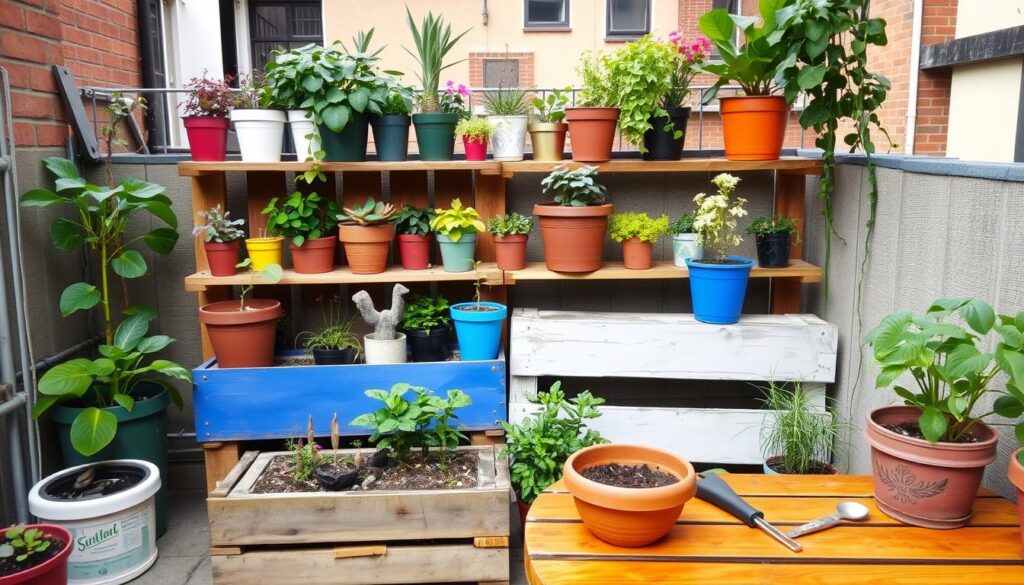
Conclusion: Embrace the Joy of DIY Gardening
As you finish this journey, we urge you to dive into the joy of DIY gardening, even in small spaces. Upcycling, creativity, and hard work have shown us the endless ways to make a beautiful, useful green space. This article has highlighted how you can make a garden that fits your needs and tastes.
Whether you’re making a colorful container garden, turning your balcony into a city oasis, or building fairy gardens, let your inner artist shine. By trying out the DIY garden projects, you’ll see the perks of small, eco-friendly gardening. You’ll enjoy the excitement of seeing your plants grow and the pride of making your own green space.
So, grab your tools, get ready, and start your DIY gardening adventure. The happiness, peace, and personal joy waiting for you are incredible. Take this path, and watch your small space turn into a lush, lively oasis that shows off your unique style and personality.
FAQ
What are some creative DIY container gardening ideas for small spaces?
This article shows you how to turn everyday items like buckets and suitcases into unique planters. It also talks about hanging planters and plant towers for vertical gardening. These ideas let you grow flowers, herbs, and veggies in small spaces.
How can I transform my balcony into a lush, inviting urban oasis?
For a cozy balcony garden, use hanging baskets and vertical planters. The article suggests small raised beds and tips for choosing the right plants. It helps you arrange your balcony garden for beauty and functionality.
What are some affordable, DIY raised bed options for my patio garden?
You can make raised bed gardens with repurposed wood and containers. The article explains the benefits of raised beds and how to build them. It helps you use your patio space well.
How can I create a whimsical miniature fairy garden in my small outdoor space?
For a fairy garden, use repurposed containers and natural materials. The article gives ideas for designing these magical spaces. It shows how to make your garden a place of wonder and joy.
What are some tips for starting an herb garden in my small-space garden?
Try DIY herb garden projects like tiered planters and vertical walls. The article helps you choose the best herbs and design a space-saving garden. It’s perfect for indoor and outdoor settings.
How can I add budget-friendly DIY decor to my small-space garden?
Use items like bottles and birdhouses to decorate your garden. The article also shows how to make garden markers and rustic decor with natural materials. This lets you add a personal touch without spending a lot.
What are some essential tips for a beginner gardening in small spaces?
Container gardening and raised beds are great for small spaces. The article offers advice on choosing plants, managing sunlight, and using space well. It also covers budgeting, DIY projects, and sustainable gardening to help you succeed.
Source Links
- DIY Gardening Ideas: A Guide to Creating a Spring Garden – https://thediymommy.com/diy-gardening-ideas-a-guide-to-creating-a-spring-garden/
- Inexpensive Raised Garden Bed Ideas: DIY Inspiration – https://savvygardening.com/inexpensive-raised-garden-bed-ideas/
- Landscaping on a Budget: DIY Garden Design – https://www.roundrockgardens.com/post/landscaping-on-a-budget-diy-garden-design
How to Create a No-Till Garden
Imagine a garden that grows well without tilling or disturbing the soil. It needs less time and effort but still gives lots of fresh, healthy food. Welcome to no-till gardening, a way to grow food that’s good for the planet. But what makes it so special?
Key Takeaways
- No-till gardening is a sustainable method that minimizes soil disturbance and enhances soil health.
- It requires less time and effort, making it an ideal choice for busy gardeners.
- No-till gardening helps retain moisture, suppress weeds, and improve soil fertility through the use of mulch and compost.
- This approach mimics natural ecosystems, creating a thriving, low-maintenance garden.
- By understanding the benefits and methods of no-till gardening, you can transform your outdoor space into a flourishing, eco-friendly oasis.
Understanding No-Till Gardening
Imagine a garden that grows well without the need for constant tilling. No-till gardening is all about this idea. It skips using machines or shovels to disturb the soil. Instead, it adds organic material on top of the soil every year. This helps plants grow better.
What is No-Till Gardening?
No-till gardening is a way to keep the soil healthy and fertile without tilling. It keeps the soil’s structure good and helps plants grow better. This method also helps with carbon sequestration, brings in earthworms, and makes the soil easier for roots to spread out. It helps with water retention, keeps weeds down, and prevents erosion.
Benefits of No-Till Gardening
The main advantages of no-till gardening are:
- Better soil health and fertility
- More water retention and less erosion
- More carbon sequestration and less greenhouse gas
- Less weed suppression and less work
Using this gardening method makes your garden healthy and easy to care for. It works well with nature, supports sustainable gardening, and gives you lots of food.
Popular No-Till Gardening Methods
If you’re looking into no-till gardening, there are several methods to try. Charles Dowding’s no-dig gardening and Paul Gautschi’s Back to Eden method are popular. They offer unique benefits for different gardening styles.
No-Dig Gardening
No-dig gardening uses cardboard to stop weeds and adds compost yearly to improve soil. This method skips tilling, which can harm soil structure and its tiny life. By not disturbing the soil, gardeners create rich, healthy soil for plants.
Back to Eden Method
Paul Gautschi created the Back to Eden method. It uses wood chips as mulch that breaks down into soil. This method copies nature, where leaves and organic matter make fertile soil. The mulch stops weeds, keeps soil moist, and helps good soil life.
Ruth Stout’s No-Work Garden
Ruth Stout’s method uses hay or straw as mulch. Adding layers of this material builds nutrient-rich soil without digging. This mulch keeps soil moist, kills weeds, and helps earthworms and other creatures.
These no-till gardening methods let you pick what works best for you. Whether it’s no-dig, Back to Eden, or Ruth Stout’s method, you can have healthy soil easily. You won’t need to till the soil.
Selecting the Right Location
Choosing the right spot for a no-till garden is key to its success. Look for a place with plenty of sunlight exposure. Some plants prefer partial shade to avoid the hottest sun. A flat terrain helps water spread evenly, and being close to a water source makes upkeep easy.
Think about these important points when picking the best spot for your garden:
- Sunlight Exposure: Pick a spot that gets at least 6 hours of direct sunlight daily. Some plants do well in partial shade too.
- Flat Terrain: A flat area means water spreads evenly and prevents water from pooling or draining poorly.
- Water Accessibility: Being close to a hose or other water source makes caring for your garden easier.
- Soil Quality: Choose soil that’s rich in nutrients and drains well to support your garden’s growth.
By picking the right garden location, you’re setting up for a garden that’s easy to maintain and full of produce year after year.
Choosing the Best No-Till Method
When picking a no-till gardening method, think about your climate, the crops you want to grow, and how you’ll control weeds and retain moisture. Also, consider the cost, your long-term goals, and the look you want for your garden. These factors help pick the best no-till method for you.
Some no-till methods, like the Back to Eden or Ruth Stout methods, work better in certain climates or for specific crops. By looking at these factors, you can pick a method that fits your gardening goals and vision.
Factors to Consider
- Climate: Knowing your local climate and how it affects plants is key when choosing a no-till method. Some methods are better at handling moisture or climate challenges.
- Crop Selection: The crops you grow can affect the no-till method you use. Some methods work better for certain plants or growing needs.
- Weed Control: Managing weeds well is crucial in no-till gardens. Some methods are great at keeping weeds down and gardens healthy.
- Moisture Retention: Keeping soil moist is a big plus of no-till gardening. Look at how different methods handle moisture to pick the best one for your climate and watering needs.
- Cost: The cost to start and keep up a no-till garden varies. Think about your budget and how each method compares in cost over time.
- Long-Term Goals: Think about what you want from your garden in the long run, like soil health or a certain look. This can help you choose the right no-till method.
- Aesthetic: How your garden looks is important to many gardeners. Some no-till methods can make your garden look more natural or tidy.
By thinking about these factors, you can pick a no-till gardening method that fits your needs, tastes, and goals. This ensures a garden that’s healthy, sustainable, and looks great.
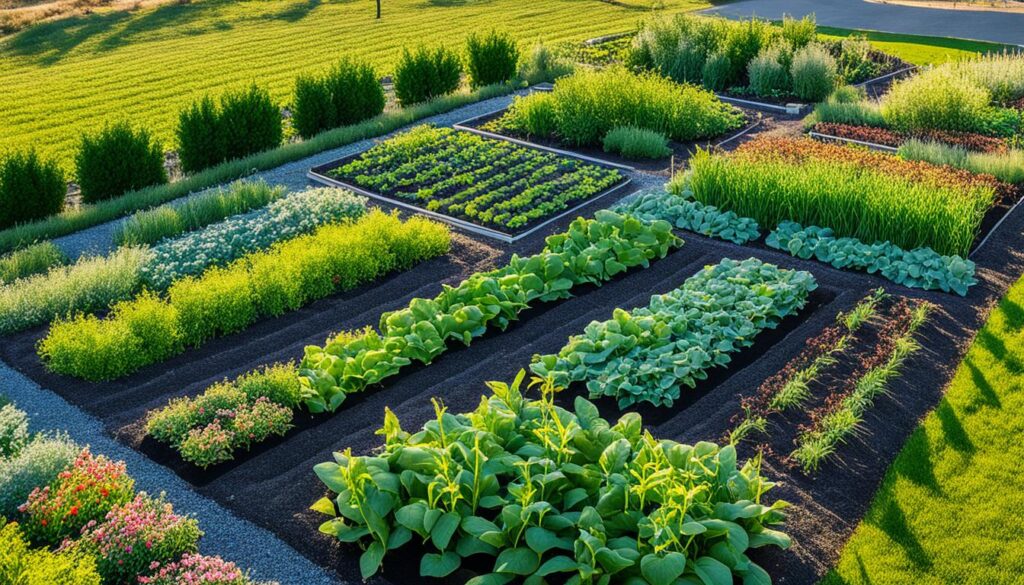
“The key to successful no-till gardening is finding the method that works best for your specific growing conditions and goals.”
Planning Your No-Till Garden Layout
Starting your no-till garden requires careful planning. The size and shape of your beds and walkways are key. They affect how well your garden works and how much you can grow. By planning well, you can make a garden that is both beautiful and productive.
One good way to set up your garden is with 5-6 foot wide beds that are 50 feet long. Add 3 foot wide paths between them. This lets you easily reach the middle of the beds and use your space well. You might also consider square foot gardening, which breaks your beds into smaller sections for better planting.
First, draw a plan of your garden. Think about the garden bed size and walkway planning that fits your space and needs. This plan will help you use your garden space well and make your growing season successful.
“A well-planned garden layout is the foundation for a thriving no-till garden.” – Gardening Guru, Jane Doe
For a great no-till garden, balance is key. Plan your layout carefully to make sure your garden is both efficient and easy to get around in. With good planning, you can have a garden that is full of life and easy to take care of.
Gathering Supplies for No-Till Gardening
Starting your no-till gardening journey means you need the right supplies. You might be using the no-dig gardening method, the Back to Eden method, or Ruth Stout’s approach. The key materials needed are similar across all these methods.
Essential Materials
Here are the basic supplies you’ll need for no-till gardening:
- Cardboard or newspaper to keep weeds away
- High-quality compost to make the soil rich
- Mulching materials like wood chips, leaves, or rotted hay for the beds
Make sure you have more of these supplies than you think you’ll need. Full coverage of your garden beds is key for no-till gardening to work well. The exact supplies you need may change based on the method you choose.
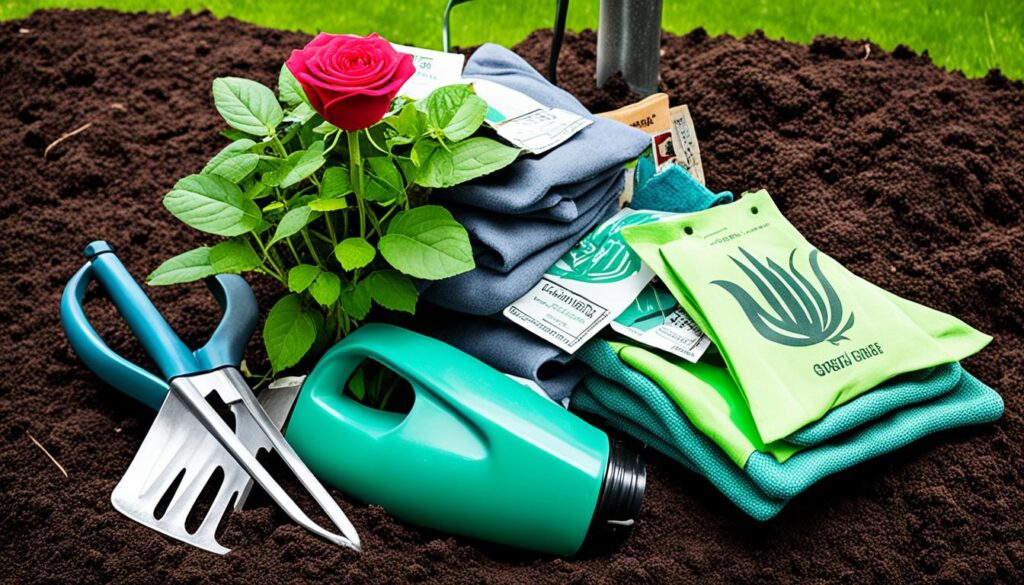
“Preparation is the key to a successful no-till garden. Ensure you have an ample supply of the essential materials before starting your project.”
With the right no-till gardening supplies, like cardboard, compost, and mulch, you’re ready to create a garden. This garden will be healthy, easy to maintain, and will help the soil and reduce weeds.
Preparing the No-Till Garden Beds
Starting a no-till garden means getting the beds ready. It’s all about stopping weeds and adding organic matter. These steps help your plants grow well.
Suppressing Weeds and Grass
To begin, kill the weeds and grass in your garden beds. Use cardboard or newspaper to block sunlight. This stops the plants from making food and they will die.
With the weeds gone, you’re ready for a clean space to plant.
Building Organic Matter Layers
After getting rid of weeds, start adding organic layers. Put down 3-4 inches of compost first. Compost is full of nutrients that help plants grow.
Then, add a 4-6 inch layer of mulch, like wood chips or rotted hay. Mulch keeps the soil moist, stops weeds, and adds more organic matter.
“Healthy soil is the foundation for a thriving no-till garden. By taking the time to properly prepare the beds, you’re setting your plants up for success.”
By stopping weeds and adding organic layers, your garden is ready to grow. You’ve given your plants a strong start. Now, you can plant with confidence, knowing your plants will do well.
no-till gardening
No-till gardening has many benefits over traditional tilled gardens. It avoids disturbing the soil and keeps adding organic matter. This approach improves soil health, boosts plant yields, and cuts down on maintenance.
This method, which mimics nature, helps with water retention, reduces weeds, and attracts beneficial organisms like earthworms.
One big plus of no-till gardening is its effect on soil health. By not tilling, you keep the important networks and structure of the soil intact. These are key for nutrients and water to move around easily. This leads to soil that’s strong against drought, pests, and diseases.
Another big benefit is the potential for more plants. Without the damage from tilling, plants can grow better. Plus, the soil holds more moisture and nutrients, making for bigger and healthier crops.
Lastly, no-till gardening is easier to maintain. It keeps weeds down and builds up organic matter. So, you’ll spend less time on weeding, cultivating, and adding stuff to the soil. This makes it a sustainable and easy way to grow a garden full of vegetables or flowers.
| Benefit | Description |
|---|---|
| Improved Soil Health | Preserves soil structure and mycorrhizal networks, leading to better nutrient cycling and water absorption. |
| Higher Plant Yields | Allows plants to focus on growth rather than repairing root damage, with increased moisture and nutrients. |
| Reduced Maintenance | Suppresses weeds and maintains organic matter, requiring less time and effort on tasks like weeding and cultivating. |
By using no-till gardening, you can make a garden that’s full of life and needs little upkeep. It feeds the soil and helps a wide variety of helpful organisms. The payoff is big harvests and a garden that’s strong and healthy.
Planting in Your No-Till Garden
Planting in a no-till garden needs some special steps to help your seeds and plants grow well. By using the best methods, you can make your garden successful for a long time.
Planting Seeds
When you plant seeds, move the mulch aside first. This lets seeds like carrots grow well by touching the soil. Once they sprout, put the mulch back, but don’t cover the young plants too much.
Planting Starts and Transplants
Before moving seedlings, loosen their roots to stop them from being too tight. Plant them at the same level as before, but don’t cover them too deep. After moving, put mulch back around the plants, but not on the leaves.
Good planting habits and careful attention will make your no-till garden flourish. By following these tips, you’ll give your seeds, seedlings, and transplants a great start in your garden.
Conclusion
No-till gardening is a great way to grow a garden that’s both sustainable and easy to care for. It doesn’t disturb the soil and keeps adding organic stuff to it. This makes the soil healthier, helps plants grow better, and means you don’t have to work as hard.
Choosing the no-dig, Back to Eden, or Ruth Stout method is important. The goal is to make your garden act like nature does. This helps plants grow the best they can.
With the right spot, plan, and setup, you can have a no-till garden that’s a success. Using sustainable gardening and organic ways, you’ll have a garden that’s easy to keep up and lasts a long time.
This article has given you the tips you need to make your garden a place that takes care of itself and the earth. Start no-till gardening and see how amazing your garden can become.
FAQ
What is no-till gardening?
No-till gardening uses cardboard, newspaper, compost, and mulch to fight weeds and improve soil. It helps create a healthy garden with fewer weeds and better soil.
What are the benefits of no-till gardening?
No-till gardening boosts soil health and fertility. It also helps with water retention, reduces weeds, and cuts down on soil erosion. This method keeps carbon in the soil, attracts earthworms, and helps roots grow better.
What are some popular no-till gardening methods?
Popular no-till methods include the no-dig, Back to Eden, and Ruth Stout gardens. Each method uses organic layers to control weeds and enhance soil health.
How do I choose the right location for a no-till garden?
Pick a spot that gets lots of sunlight, is flat, and has easy access to water. These conditions help your no-till garden thrive.
What should I consider when choosing a no-till gardening method?
Think about your climate, the plants you want to grow, and how to control weeds and moisture. Consider your budget, goals, and the look you want for your garden. This will help you pick the best no-till method for you.
How do I plan the layout of my no-till garden?
Plan your garden with 5-6 foot wide beds and 3 foot wide paths. Or, use the square foot gardening method for efficient planting. This layout helps you make the most of your space.
What supplies do I need to get started with no-till gardening?
You’ll need cardboard or newspaper for weed control, good compost for soil, and mulch like wood chips or leaves. The supplies vary by the no-till method you choose.
How do I prepare the no-till garden beds?
Start by laying down cardboard or newspaper to kill weeds. Then, add a 3-4 inch compost layer, followed by 4-6 inches of mulch.
What are the benefits of no-till gardening compared to traditional tilled gardens?
No-till gardens have better soil health and produce more plants with less work. They keep moisture in, fight weeds, and attract earthworms by not disturbing the soil and adding organic matter.
How do I plant in a no-till garden?
Lift the mulch to plant seeds and let them grow. For seedlings, loosen their roots before planting. Plant them at the same level as before, cover with mulch, but keep it off the leaves.
Source Links
- https://sunshinefarmny.com/2021/05/11/how-to-start-a-no-till-garden-from-scratch/ – How to Start a No-Till Garden from Scratch
- https://northernhomestead.com/starting-a-new-no-till-garden-with-tilling/ – Starting a new no-till garden with tilling
- https://rootsandrefuge.com/no-till-gardening-the-various-methods/ – No-Till Gardening (The Various Methods)
Using Technology to Enhance Sustainable Gardening
Technology is changing every part of our lives, including gardening. You might ask, “How can tech help make my garden more sustainable and efficient?” The answer is in new solutions that are changing how we garden.
Smart gardening tools and precision agriculture are here to change the game. This article will show you how technology can make your garden better. It will help you create a garden that’s good for you and the planet.
Key Takeaways
- Discover innovative smart gardening tools that automate tasks and improve efficiency
- Learn how to leverage data and AI for smarter garden planning and predictive maintenance
- Explore eco-friendly landscaping options and solar-powered gardening tools
- Understand how precision agriculture techniques can optimize your garden’s yield and efficiency
- Discover the benefits of vertical farming and personalized garden services
Are you ready to make your garden better with technology? Let’s explore the new innovations in sustainable gardening.
Smart Gardening Tools and Automation
In today’s digital world, smart gardening tools are changing how we care for our gardens. They give us real-time info on soil health, moisture, and more. This helps homeowners and garden pros make better choices and automate gardening tasks.
Real-time Data and Automated Features
Smart gardening tools come with sensors and can connect to the internet. They let you check on your plants and soil nutrients right from your phone. With these tools, you can save time and make sure your garden stays healthy with less work.
Features like self-driving lawn mowers and automated pruning are making gardening easier. The future of gardening looks like it will be more about relaxing and enjoying the results.
AI Garden Planning and Predictive Maintenance
Artificial intelligence (AI) is now a big part of garden planning and maintenance. AI looks at your garden’s specific needs, soil, and weather to give you tailored advice on what to plant and when. It can also spot problems like pests or diseases before they start.
This means you can keep your garden looking great with less hassle. AI helps you stay ahead, ensuring your garden stays lush and healthy.
“Smart gardening tools are transforming the way we interact with our outdoor spaces, making gardening more efficient, convenient, and sustainable than ever before.”
Sustainable Landscaping and Eco-Friendliness
The gardening world is going green, using eco-friendly materials, native plants, and natural fertilizers. We’re also cutting down on water use and using solar-powered or electric gardening tools. These changes help the planet and save money on upkeep.
Eco-friendly Materials and Native Plants
Choosing the right materials is key for a green garden. Use recycled or renewable stuff like recycled plastic, bamboo, or reclaimed wood for beds, paths, and more. Adding native plants helps local wildlife and cuts down on water and chemicals.
Solar-Powered and Electric Gardening Tools
Using renewable energy for your gardening tools is a smart move. Solar-powered mowers and trimmers cut down on gas and electricity use. Electric gardening tools with rechargeable batteries are also a great choice.
| Sustainable Landscaping Feature | Benefits |
|---|---|
| Eco-friendly materials | Reduced environmental impact, lower maintenance costs |
| Native plants | Attract local wildlife, require less water and maintenance |
| Solar-powered and electric tools | Renewable energy sources, reduced carbon emissions, lower operating costs |
Adding these green practices to your garden makes it beautiful and helps the planet. It’s a win-win for you and the environment.
gardening technology
Technology has changed the game in modern gardening. It makes lawn care, hedge trimming, and weed control easier. No more manual labor or spending hours on tasks. Gardening technology brings efficiency, sustainability, and accessibility to our gardens.
Now, you can book lawn mowing and trimming online. Smart gardening tools automate routine tasks. This tech revolution lets homeowners manage their gardens easily, saving time for other hobbies.
But there’s more. Modern gardening tools like robotic lawnmowers and high-tech chainsaws are getting popular. With repair services and online tutorials, maintaining these tools is simple. This lets homeowners take charge of their gardens.
“Technology has revolutionized the way we approach gardening, making it more efficient, sustainable, and accessible than ever before.”
These new tools are changing gardening for the better. They help us garden sustainably and reduce our environmental impact. Tools and systems like energy-efficient ones and automated watering systems are making gardens greener and healthier.
The digital age is opening up new possibilities in gardening. Whether you’re an expert or new to gardening, today’s modern gardening tools and services are changing how we garden and enjoy our outdoor spaces.
Precision Agriculture: Optimizing Yield and Efficiency
Precision agriculture is changing the game in sustainable gardening and farming. It uses advanced tech to boost crop yield and use resources better. This leads to a greener future. At its core are GPS mapping and remote sensing, which are changing how we manage land.
GPS Mapping and Remote Sensing
GPS mapping gives gardeners and farmers exact field details and topography. This lets them adjust their methods for each area’s needs. It cuts down on waste and makes the most of every piece of land.
Remote sensing adds to this with tools like satellite images and drones. These give real-time updates on crops, soil, and weather. This info helps gardeners and farmers make smart choices for better yields and gardening.
Data Analytics for Strategic Insights
Data analytics boosts the power of precision agriculture. It turns big data into insights that guide planting, watering, and fighting pests. This approach increases yield optimization and efficient gardening, reducing waste and saving resources.
Precision agriculture is a bright spot in the quest for sustainable food. It combines GPS, remote sensing, and data analytics. This approach is changing how we farm and manage land, leading to better efficient gardening and yield optimization in the future.
Vertical Farming: A Solution for Urban Agriculture
As cities grow and we need more food, vertical farming is becoming key. It lets us grow crops up high, making the most of small city spaces. This way, we use less land and hurt the environment less.
Vertical farms use cool tech like hydroponics and aeroponics to feed plants well. They use much less water than old-school farms. This means we get fresh, healthy food all year, not just when it’s in season.
| Benefit | Impact |
|---|---|
| Water conservation | Vertical farms can use up to 95% less water than traditional agriculture. |
| Year-round production | Vertical farms can grow crops in a controlled environment, independent of seasonal fluctuations. |
| Reduced carbon footprint | Vertical farms minimize the need for long-distance transportation, cutting down on greenhouse gas emissions. |
Some vertical farms even use solar power, making them even greener. This makes urban agriculture and vertical farming more eco-friendly. As cities get bigger, vertical farming is a big part of the solution for feeding the future.
“Vertical farming is not just about growing food – it’s about growing a more sustainable future for our cities.”
Personalized Garden Services and Virtual Tours
The gardening world has changed a lot with technology. Now, garden services offer personalized solutions and virtual tours. They meet the unique needs and likes of their clients, making gardening fit their lives.
These services are not just about the usual gardening work. They offer everything from custom garden designs and landscaping to detailed care and lots of plants. With the latest tech, they even provide 3D garden models or virtual tours. This lets homeowners see their dream gardens before they start.
Personalized gardening aims to give each client a special experience. It looks at what each person likes, their budget, and the planet. This way, every garden shows off the homeowner’s style and needs. It uses eco-friendly stuff and plants that are native, making a beautiful and green oasis.
Whether you know a lot about gardening or are just starting, these services and tours can change your outdoor area. They help you make the most of your garden and start a journey of gardening excellence.
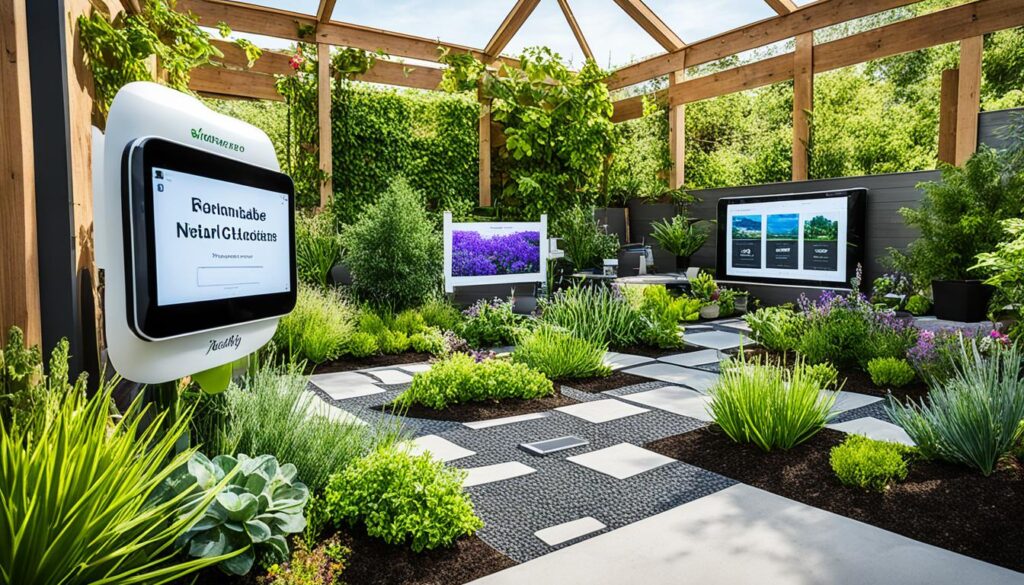
| Service | Description |
|---|---|
| Custom Garden Design | Tailored layouts and plans that reflect your unique preferences and lifestyle |
| Eco-Friendly Landscaping | Sustainable materials and native plant selection for a harmonious outdoor space |
| Virtual Garden Tours | Immersive 3D models and online walkthroughs to envision your dream garden |
| Personalized Maintenance | Customized care and upkeep to ensure your garden thrives year-round |
Sharing Economy Approach to Gardening
The sharing economy has changed how we garden. Platforms like Parkbench, Neighborgoods, and Letgo let gardeners connect and share. This creates a team effort in gardening, making it easier for more people to garden while saving resources.
Communal Gardening and Resource Pooling
Gardeners no longer need to buy their own tools and equipment. They can use what’s shared in their community. This saves money and cuts down on waste by using things better.
People can share garden plots, seeds, and advice. This builds a strong network of gardeners who support each other.
This way of gardening fits well with wanting to be more green and caring for the planet. Sharing things means less waste and a smaller carbon footprint for everyone. It also brings people closer, creating a community feeling through gardening.
“The sharing economy has made gardening more accessible and inclusive than ever before. By pooling our resources, we’re not only saving money but also building stronger, more sustainable communities.”
Whether you’re new to gardening or have been doing it for years, the sharing economy has lots of perks. It makes gardening cheaper and connects you with others who share your interests. This new way of gardening is changing how we grow our gardens and build our communities.
Challenges and Opportunities in Agri-Tech Innovations
The world of agri-tech innovations is full of potential but also faces many challenges. These include poor rural infrastructure, digital literacy issues, and data privacy concerns. Yet, these challenges offer chances for new innovations and growth.
One big issue is the lack of good rural infrastructure. Without stable power, internet, and transport, many agri-tech solutions can’t reach those who need them most. This creates opportunities for companies working on renewable energy, smart irrigation, and better last-mile delivery.
Another challenge is getting traditional gardeners to try new things. We need strong digital literacy programs to teach gardeners about agri-tech’s benefits. By showing how these technologies can make farming better and increase yields, we can get more people to use them.
There are also big worries about data privacy. With agri-tech, there’s a lot of data that needs protecting. We must create strong data rules and clear policies on sharing data to build trust and encourage more innovation.
“As we confront global issues like climate change and food security, agri-tech proves to be an indispensable ally in our quest for a more sustainable and resilient future.”
Even with these challenges, the agri-tech industry has huge opportunities. By improving rural infrastructure, teaching digital skills, and protecting data, we can make the most of these technologies. This will lead to a more sustainable, efficient, and strong farming world.
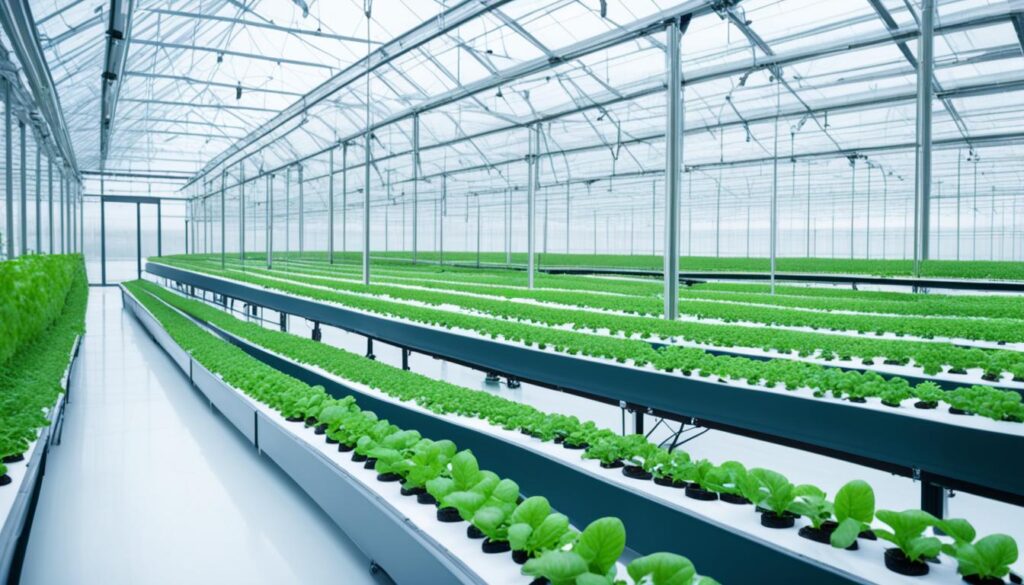
Conclusion
Gardening technology is changing the future for the better. It uses AI, machine learning, drones, precision agriculture, and vertical farming. These tools make gardening more efficient, reduce waste, and use resources wisely. They help us take care of our gardens while protecting the planet.
Even though there are challenges like poor infrastructure and resistance to new ideas, these issues also bring chances for more innovation and learning. By using these new technologies, you can change how we garden at home. Soon, taking care of plants will be easier, and smart garden management and urban gardening will be the standard.
The future of gardening looks bright. Eco-friendly gardening and sustainable gardening are becoming more popular thanks to advanced technology. Let’s welcome this future and watch our gardens grow with the help of technology.
FAQ
What are some of the key trends in smart gardening technology?
Smart gardening tools now give real-time info on soil quality, moisture, and plant health. They also automate tasks like mowing and watering. New tech like AI helps plan gardens and predict maintenance needs.
How is sustainable landscaping transforming the gardening industry?
Sustainable landscaping uses eco-friendly materials and native plants. It also means using natural fertilizers and saving water. Plus, it includes tools powered by solar or electricity to cut down on environmental harm and costs.
What are the benefits of precision agriculture in gardening?
Precision agriculture uses GPS, remote sensing, and data analysis to improve crop yields and use resources better. This helps gardeners and farmers plan better, manage water and pests, and grow more efficiently.
How is vertical farming revolutionizing urban agriculture?
Vertical farming stacks crops in urban areas, cutting down on transportation and using tech like hydroponics. This method gives plants what they need while saving water.
What are the advantages of personalized garden services and virtual tours?
Personalized garden services tailor solutions to each client, from design to maintenance. They also offer 3D models or virtual tours. This gives a unique gardening experience that meets individual needs and tastes.
How can the sharing economy approach benefit gardening enthusiasts?
Sharing economy platforms let gardeners share tools and resources. This reduces waste, builds community, and makes gardening cheaper and more accessible.
What are some of the challenges and opportunities in the adoption of agri-tech innovations?
Challenges include poor rural infrastructure, resistance to new tech, and digital skills gaps. But, these issues also open doors for more innovation. Solutions for reliable infrastructure and education could promote agri-tech’s benefits.
Source Links
- https://sustainablereview.com/tech-innovations-in-sustainable-agriculture/ – Tech Innovations in Sustainable Agriculture — Sustainable Review
- https://verdenook.com/articles/future-of-sustainable-gardening-green-technologies-innovations – Unveiling the Evolution of Sustainable Gardening: Green Technologies & Innovations
- https://wearelikeminds.com/the-future-of-gardening-services-innovations-technology-and-sustainability/ – The Future of Gardening Services: Innovations, Technology, and Sustainability. – Like Minds
Building Eco-Friendly Garden Structures
Are you ready to turn your garden into a sustainable haven? Picture a place where man-made and nature blend together perfectly. Here, every part of the garden has a purpose and helps the planet.
In your garden, you can make structures that are both useful and good for the earth. Think about green roofs that look like nature or earth-sheltered designs that fit right in. Using natural and recycled materials lets you build unique, eye-catching structures. These show your love for the environment.
Key Takeaways
- Explore the harmonious integration of man-made and natural elements in garden structures
- Discover the benefits of green roofs and earth-sheltered designs for your sustainable garden
- Learn how to utilize natural, recycled, and repurposed materials for your eco-friendly projects
- Understand the importance of strategic positioning and orientation for maximizing the benefits of your garden structures
- Dive into the world of sustainable foundations, insulation, and renewable energy sources for your green garden
Are you ready to rethink garden structures and make a space that mirrors your values? Discover the secrets of eco-friendly garden design. Start your journey to a greener, more peaceful outdoor space.
Eco-Friendly Garden Structures: Harmonizing Man-Made and Nature
Creating a balance between man-made and nature is key in eco-friendly gardens. Green roofs and earth-sheltered designs are great ways to blend the built world with nature.
Green Roofs: A Sustainable Solution
Green roofs, also known as turf roofs, are a smart choice for gardens. They use soil and native plants to cover buildings. This makes a living roof that helps with energy use, air quality, and supports wildlife.
These roofs look good and work well. Picking plants right for your area means they need little care. They also help the garden feel like one piece with the building.
Earth-Sheltered Designs: Blending with the Landscape
Earth-sheltered structures are another great idea for eco-friendly gardens. They sit partly underground, letting the garden cover the roof. This makes the garden and building look like they’re together.
These designs look nice and are good for the planet. They use less energy and have a smaller environmental footprint.
Natural Building Materials: A Sustainable Choice
Using natural building materials for eco-friendly garden structures is a big step forward. Cob, adobe, and straw bales bring a unique look that fits right into nature. They create a beautiful link between the built environment and nature.
These materials are not just pretty; they’re also good for the planet. Cob is a mix of clay, sand, and straw that can be shaped into many forms. Adobe is a classic choice, made from earth, water, and sometimes straw. It keeps buildings warm and lasts a long time. Straw bales are great for keeping buildings cool in the summer and warm in the winter.
| Material | Key Features | Sustainability Benefits |
|---|---|---|
| Cob | Moldable, unique shapes | Locally sourced, biodegradable |
| Adobe | Excellent thermal performance, durable | Made from earth, water, and straw |
| Straw Bales | Impressive insulation properties | Renewable, energy-efficient |
Choosing natural building materials makes your garden look great and helps the planet. These options let you build spaces that are both beautiful and eco-friendly. They make your garden and its features work together in harmony.
“Sustainable construction is not just about the end result; it’s about the journey, the materials, and the impact we have on the environment.” – Jane Doe, Sustainable Design Expert
Recycled and Repurposed Materials: Giving New Life
In the world of eco-friendly garden structures, recycled and repurposed materials are key. They offer a green alternative to traditional building methods. By using reclaimed resources, you can make unique and beautiful structures that fit right into nature.
Reclaimed Timber: A Timeless Classic
Reclaimed timber is a top choice for eco-friendly garden structures. It brings a rustic look and connects you to history. It comes from old barns, warehouses, or taken-down buildings, adding real character to your garden.
Upcycling Materials: Creativity Meets Sustainability
Upcycling opens up many ways to make eco-friendly garden structures. You can use repurposed doors, windows, metal frames, and vintage décor. With a little creativity, you can make one-of-a-kind structures that show off your style and care for the planet.
| Material | Sustainability Benefits | Potential Garden Applications |
|---|---|---|
| Reclaimed Timber | Reduces waste, preserves natural resources | Arbors, trellises, garden sheds, fencing |
| Repurposed Doors | Diverts materials from landfills, promotes creativity | Garden gates, small greenhouses, potting benches |
| Salvaged Metal | Conserves resources, prevents further mining | Ornamental structures, trellises, garden art |
Using recycled materials, reclaimed timber, and upcycling lets you make garden structures that are beautiful and eco-friendly. They can make your outdoor space look great and help the planet.
Eco-Friendly Garden Structures: Positioning and Orientation
When designing eco-friendly garden structures, where you place them is key. Think about the sun, shade, and the land around you. This way, your structure fits well with nature.
Maximizing Natural Light and Shade
Where you put your garden structure affects how much sun and shade it gets. This is good for the structure and the plants and areas around it. By placing it right, you can use less artificial light and heat, saving energy.
- Look at how the sun moves and where the shade is in your garden. This helps you decide the best spot for your structure.
- Use design tricks like strategic window placement and overhanging roofs to control sunlight.
- Use trees, trellises, or arbors for shade in the summer.
By matching your structure with the sun and the land, you make your outdoor space look and work better.
| Garden Structure Placement | Sun Exposure | Shade | Landscape Integration |
|---|---|---|---|
| Optimal positioning | Maximum natural light | Strategically placed shade elements | Harmonious with the surrounding environment |
| Consideration of terrain and existing features | Reduced need for artificial lighting | Cooling during hot months | Blending with the natural landscape |
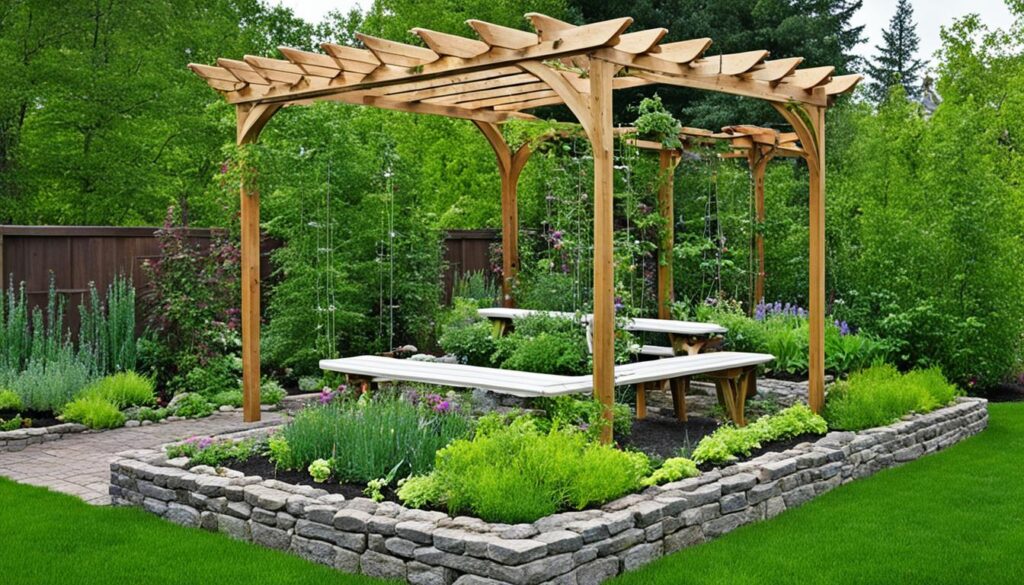
“By aligning the garden structure’s orientation with the sun’s path and the existing landscape features, you can create a seamless integration that enhances the overall aesthetic and functionality of your outdoor living space.”
Sustainable Foundations: Ground Screws and Pile Driving
Building eco-friendly garden structures is key to a green lifestyle. Traditional concrete foundations harm the landscape. But, there are better options that let you build your dream garden without hurting nature.
Ground screws are a great choice. They screw into the soil, making a strong base for your garden. This way, you skip the need for big digging and concrete, keeping your garden peaceful.
Pile driving is another green option. It uses metal or wooden posts to create a solid foundation. This method is perfect for tough soil, needing little site prep. It’s a smart pick for gardens in hard-to-dig areas.
| Foundation Type | Sustainability | Minimal Disruption | Suitability |
|---|---|---|---|
| Ground Screws | High | High | Ideal for various soil types |
| Pile Driving | High | High | Suitable for challenging soil conditions |
Choosing these green foundations means you get to enjoy your garden without harming the environment. You’ll have a beautiful garden that shows your love for the planet. With less damage to the landscape, your garden will look great and be eco-friendly.
Insulation and Energy Efficiency: Keeping it Green
Building eco-friendly garden structures means focusing on insulation and energy efficiency. Structural Insulated Panels (SIPs) are a great solution. They combine insulation into one panel, making installation easy. SIPs keep your space warm or cool, often better than building codes require.
To make your garden structure even greener, add renewable energy sources. Solar panels use the sun’s power for electricity. This cuts down on carbon emissions and can save you money on energy bills.
Structural Insulated Panels (SIPs)
- Integrated insulation eliminates the need for separate installation
- Highly effective at maintaining thermal comfort
- Exceeds energy efficiency requirements of building codes
Renewable Energy Sources
- Solar panels to harness the power of the sun
- Reduce carbon footprint and lower energy bills
- Contribute to the overall sustainability of the garden structure
| Feature | Benefit |
|---|---|
| Structural Insulated Panels (SIPs) | Exceptional insulation and energy efficiency |
| Renewable Energy Sources (Solar Panels) | Clean, sustainable power generation |
By focusing on insulation and renewable energy, you can make a garden structure that’s both beautiful and eco-friendly.
“Sustainable garden design is about more than just aesthetics – it’s about creating a space that minimizes its impact on the planet.” – Sustainability Expert
Water Conservation: Rainwater Harvesting Systems
Rainwater harvesting is a key way to save water in eco-friendly gardens. By adding these systems to your garden, you can collect and store rainwater. This helps reduce the strain on city water supplies.
Harvesting rainwater has many benefits. It lets you manage your own water, supports the environment, and makes you more independent. You can use everything from small rain barrels to big underground tanks in your garden. This ensures you always have water for your plants.
To set up a rainwater system, you need a few things: gutters, a tank, and a way to spread the water around. By placing your garden and system parts wisely, you can make your water conservation efforts work better. This gives you peace of mind and a beautiful garden.
| Key Components of a Rainwater Harvesting System | Benefits of Rainwater Harvesting |
|---|---|
|
|
“Rainwater harvesting is a simple, yet effective way to conserve water and reduce your reliance on municipal supplies. By integrating these systems into your garden structures, you can create a more sustainable, self-sufficient outdoor oasis.”
Let rainwater harvesting help your garden work with nature. This way, you can make your outdoor space greener and more water-conserving.
Habitat Integration: Welcoming Wildlife
Creating a wildlife habitat and biodiversity in your garden is rewarding. It helps the built and wild environments work together. By adding features for local animals, your garden becomes a lively ecosystem.
Green roofs are a great idea. They offer shelter and food for birds, insects, and small animals. These roofs make your garden look better and help biodiversity by adding more wildlife habitat.
Living walls or vertical gardens also attract helpful insects and small mammals. They have native plants that feed and shelter many species. This way, they mix human-made and natural worlds together.
- Add bird houses, bat houses, and insect hotels to bring wildlife to your garden.
- Use native plants that feed and shelter local animals, making a strong wildlife habitat.
- Don’t use pesticides and herbicides as they harm the ecosystem and biodiversity.
By following natural integration, your garden becomes a sanctuary for local wildlife habitat. This approach makes your garden beautiful and peaceful. It also helps the local ecosystem stay healthy and strong.
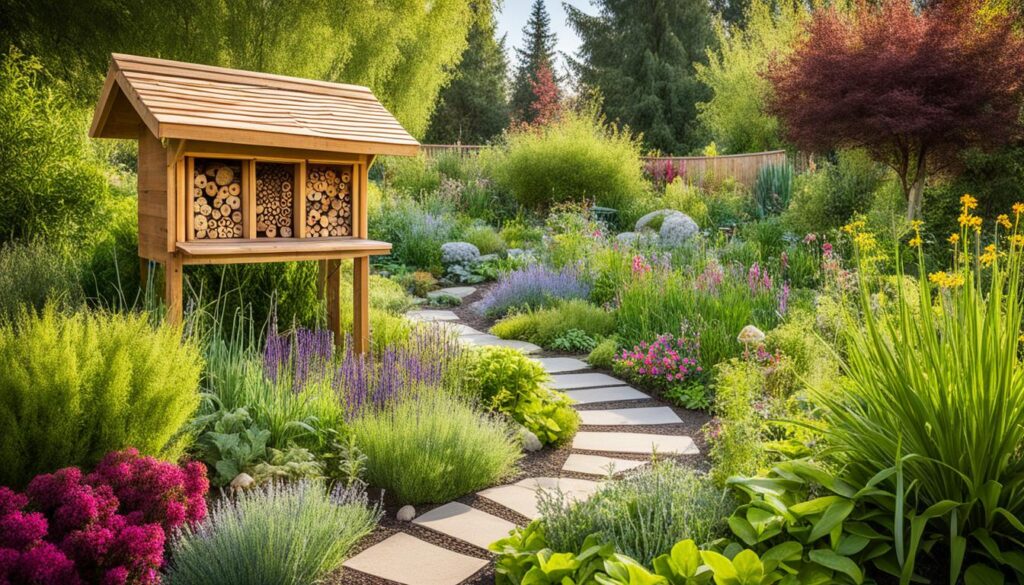
“By nurturing the natural world within our gardens, we create a harmonious coexistence that benefits both humans and the wider ecosystem.”
Conclusion: Embracing a Holistic Approach
Making eco-friendly garden structures means looking at the big picture. It’s about blending the built world with nature. By choosing sustainable materials and focusing on saving energy, these structures can become a natural part of your garden. This way, they don’t stand out as something added later.
By focusing on holistic design, sustainable living, and eco-friendly gardens, you can make your garden look better and help the local ecosystem. This approach makes your garden a place that’s good for the environment and for you.
Starting to make your garden eco-friendly? Think about everything together. Look at the materials, how much energy they use, and how they help local wildlife. This way, you can make a garden that’s really about living in harmony with nature.
FAQ
What are some of the key features of eco-friendly garden structures?
Eco-friendly garden structures often have green roofs, earth-sheltered designs, and use natural or recycled materials. They blend well with nature and offer sustainable benefits.
How can green roofs contribute to the sustainability of garden structures?
Green roofs add extra space and use local plants that fit the area well. This makes the structure and nature work together smoothly.
What are the benefits of earth-sheltered garden structures?
Earth-sheltered structures let gardens grow over them, blending man-made with nature. They can look modern or like a “hobbit house,” depending on what you like.
What types of natural building materials can be used for eco-friendly garden structures?
Materials like cob, adobe, or straw bales are great for building garden structures. They can be shaped easily and fit well with the landscape.
How can recycled and repurposed materials be used in eco-friendly garden structures?
Using recycled materials like reclaimed timber gives garden structures a classic look. Upcycling items like old doors or salvaged items is also a creative way to build sustainably.
What considerations are important when siting an eco-friendly garden structure?
Placing the structure carefully can make the most of sunlight and shade. It should match the terrain and plants, blending into the garden.
What are some sustainable foundation options for eco-friendly garden structures?
Instead of concrete, use ground screws or pile-driven foundations. These methods don’t harm the landscape much.
How can eco-friendly garden structures be designed for energy efficiency?
Insulate the structure well and add solar panels for power. Using Structural Insulated Panels (SIPs) is a great insulation choice.
How can eco-friendly garden structures integrate rainwater harvesting systems?
Design the structure to collect and store rainwater for the garden. This cuts down on municipal water use and helps conserve water.
How can eco-friendly garden structures contribute to local wildlife habitats?
These structures can support local wildlife with green roofs, living walls, or other features. This helps the natural habitat and local animals.
Source Links
- https://www.treehugger.com/rethinking-garden-shed-exciting-ideas-eco-friendly-garden-buildings-7370482 – Rethinking the Garden Shed: Exciting Ideas for Eco-Friendly Garden Buildings
- https://www.treehugger.com/tips-sustainable-garden-buildings-5206383 – Tips for Sustainable Garden Buildings
- https://www.houzz.co.uk/magazine/how-to-make-your-garden-building-eco-friendly-stsetivw-vs~150574367 – How to Make Your Garden Building Eco-friendly
Understanding Permaculture Guilds and How to Create Them
Have you ever thought about how nature thrives without our help? The answer is in the complex relationships between plants, animals, and microbes. These relationships create a self-sustaining ecosystem. This is what permaculture guilds are all about. They use nature’s systems to make gardens abundant and easy to care for. But what are permaculture guilds, and how can you use them in your garden?
Key Takeaways
- Permaculture guilds are diverse plant communities that support each other’s growth and productivity.
- Building a permaculture guild involves considering niches in time, space, and function to create a self-sustaining ecosystem.
- Permaculture guilds offer greater yields, improved soil health, and enhanced biodiversity compared to traditional monoculture plantings.
- Observing and adapting your permaculture guild is key to maintaining a thriving, low-maintenance garden ecosystem.
- Permaculture guilds can be designed around a wide range of plants, from fruit trees to annual vegetables, to create a truly diverse and productive garden.
What are Permaculture Guilds?
In sustainable gardening, permaculture guilds are getting more popular. But what are they? They are groups of plants that work well together. They help each other grow and create a healthy, self-sustaining garden.
A Brief Definition
A permaculture guild, or polyculture, is a mix of plants, animals, and soil microorganisms. It’s made to copy nature’s patterns. These guilds have many jobs, like fixing nitrogen, storing nutrients, controlling pests, and pollinating plants. They make the garden more productive and strong.
Components of a Permaculture Guild
At the center of a permaculture guild is a “star player” – usually a perennial plant. Around it, other plants are placed to help the guild work better. These plants can be:
- Nitrogen-fixing plants to enrich the soil
- Accumulators that draw up and make available essential nutrients
- Pest-repelling or disease-resistant plants
- Pollinator-attracting flowers
- Ground covers to suppress weeds and retain moisture
- Dynamic accumulators that bring up nutrients from deep in the soil
Together, these plants make a guild that is good for all living things in it. It’s a way to garden that is easy to take care of and helps everything work together.
Benefits of Building Permaculture Guilds
A monoculture may look efficient, but it’s not the best for farming. Permaculture guilds are much better. They give you many benefits like clothes, shelter, food, medicine, and help for pollinators and wildlife. They also fix damaged ecosystems.
Sustainability and Efficiency
Permaculture guilds aim for “permanent systems for persistent human existence” and sustainable farming. They copy nature to make plants, animals, and the environment work together. This leads to better use of resources and more efficiency.
Diverse Yields
With permaculture guilds, you get more than just food. You also get clothing, materials for shelter, medicine, and homes for pollinators and wildlife. These guilds make ecosystems better and provide many benefits, not just more food.
“Permaculture guilds create something bigger and better than just maximizing food production, leading to a diverse array of beneficial outputs that support a thriving polyculture.”
Designing a Permaculture Guild
Creating a permaculture guild means thinking about how plants work together. It’s about matching plants with their needs and the roles they play. This approach helps build a strong, easy-to-care-for system that keeps producing food all year.
Filling Niches in Time
Knowing when your plants grow best is key. Some love the summer, while others do well in the cool season. By mixing cool season crops and warm season crops, you can pick food all year. This way, your garden stays busy and productive.
Filling Niches in Space
Using space wisely in your guild is important. Think about the seven layers of a food forest and what’s underground too. Picking plants with different growth habits and root zones helps use space well. This approach also feeds the soil from below.
Fulfilling Beneficial Functions
Choosing plants with special jobs is crucial. Nitrogen fixers make the soil better, while dynamic accumulators pull up nutrients. Pest repellents keep bugs away, and pollinator attractors help your garden thrive. This mix makes your garden strong and easy to care for, like a healthy soil food web.
“The essence of permaculture is designing systems that mimic the patterns and relationships found in nature.”
permaculture guilds
Permaculture guilds are key to a strong, lasting ecosystem. They work like nature’s plant groups in the wild. By copying these, we can make our own guilds that help each other out. This way, we can work less and get more over time, thanks to plants that help each other.
At the core of permaculture guilds is ecosystem design. Instead of seeing your garden as separate plants, think of it as a living community. Each plant helps the others, making your garden more sustainable and powerful. This method brings out the best in your plant communities.
Choosing and placing your plants with permaculture techniques makes a self-sustaining garden. You’ll get lots of food, like fruits and veggies, plus homes for good bugs and natural pest control. A well-planned permaculture guild is full of benefits.
“A permaculture guild is a mutually beneficial group of plants that work together to create a healthy, thriving ecosystem.”
Using permaculture guilds can change how you use your land. Design your own plant communities to make a space that takes care of itself. Start with permaculture guilds and see the magic your ecosystem can do.
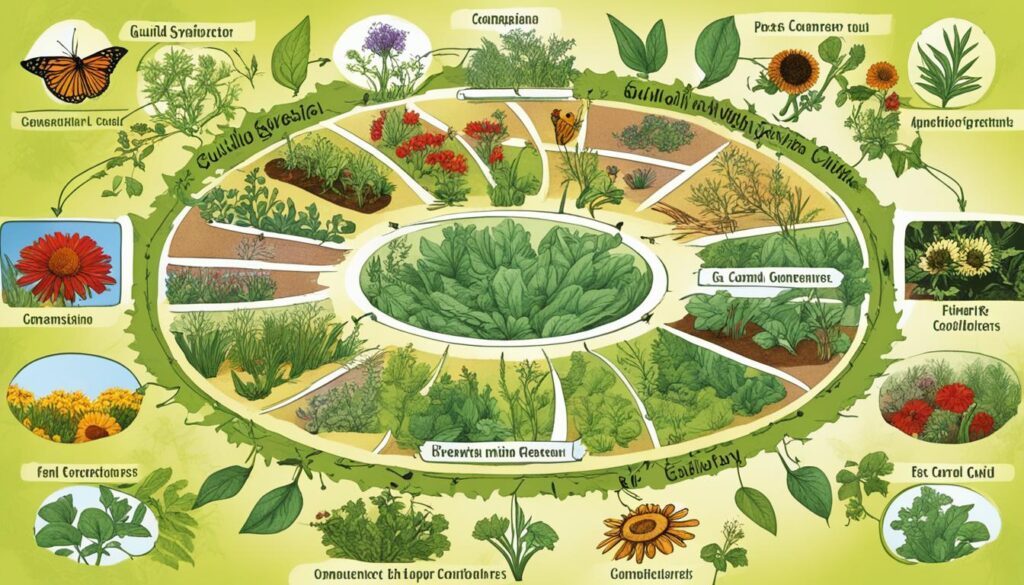
Creating a Fruit Tree Guild
Starting a fruit tree guild is crucial for a lively permaculture orchard. Choose plants that work well with your fruit tree. This creates a system that grows well and needs little upkeep.
Preparing the Space
First, clear the area around your fruit tree up to its drip line. Test the soil and add compost and mulch to make it healthier and more fertile. Terracing can also improve drainage.
Choosing Companion Plants
Then, pick the right plants to be around your fruit tree. These should include:
- Nitrogen fixers like legumes to make the soil richer
- Pest repellents to keep pests away
- Pollinator attractors for more fruit
- Ground covers to stop weeds and keep the soil moist
- Dynamic accumulators that pull up good minerals
By picking and placing these plants right, you’ll have a fruit tree guild that helps your main tree grow strong and produce well.
Examples of Permaculture Guild Plants
Choosing the right plants is key to a successful permaculture guild. You’ll want nitrogen fixers, pest repellents, and pollinator attractors. Let’s look at some plants you can use in your guilds.
Legumes like beans, peas, and lentils are great nitrogen fixers. They work with bacteria to take nitrogen from the air and add it to the soil. This helps other plants grow strong.
Herbs and flowers like garlic and marigolds keep pests away naturally. Their strong smells confuse pests, protecting your other plants.
Flowers like sunflowers and borage attract bees and butterflies. These insects are key for pollination and garden health.
Plants like comfrey and rhubarb are mulchers. They add organic matter to the soil, keeping it moist, weed-free, and fertile.
Then there are dynamic accumulators like borage and chickweed. They pull nutrients from deep in the soil and bring them up for other plants.
By using a mix of these plants, you can make a permaculture guild that takes care of itself. Watch, try new things, and let nature help you create a thriving garden.
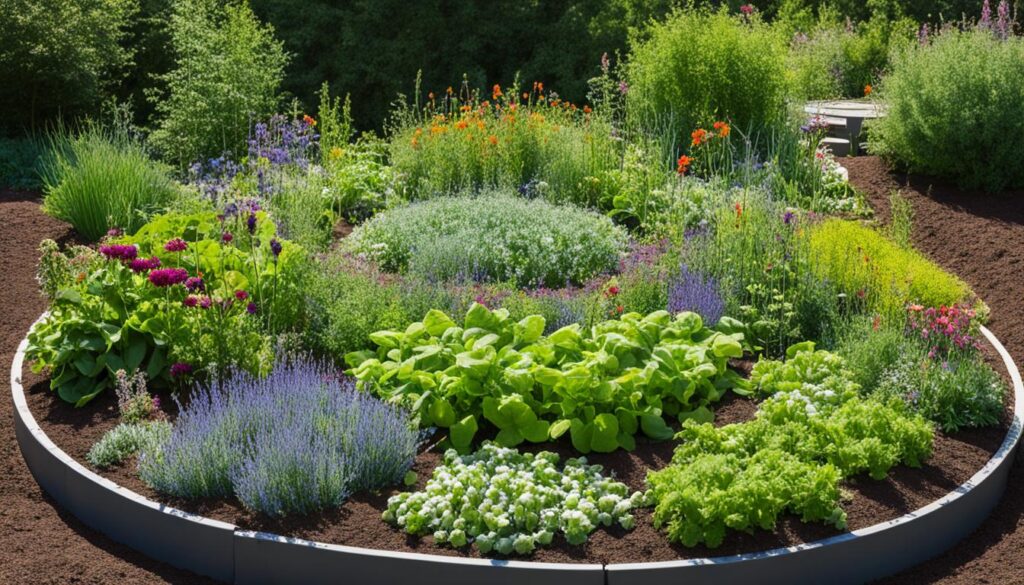
Observing and Adapting Your Guild
Permaculture guilds are not set recipes but starting points for permaculture design and experimentation. It’s important to see how your guild does in your specific site-specific adaptations and adjust as needed. Making changes to fix problems is key to a successful, easy-to-maintain permaculture guild.
Start by watching how the plants in your guild interact. Are they doing well and doing what they’re supposed to? Look for signs of nutrient shortages, pests, or system imbalances. This experimental approach helps spot areas that need work.
- Add or replace plants that aren’t doing well.
- Fix nutrient issues by changing the soil or adding new plants.
- Use organic ways to control pests.
Every site is different, so your permaculture guild will need site-specific adaptations to succeed. Be open to learning and changing as needed. With patience and attention, you can make a system that takes care of itself and gives lots of different foods.
“The true test of a permaculture design is not how it looks on paper, but how it performs in reality.”
By watching and adapting your permaculture guild, you can make it better and more resilient. Enjoy the journey of permaculture design and the benefits of a thriving, easy-to-maintain guild.
Building a Low-Maintenance Ecosystem
Crafting a permaculture guild means making a system that works like nature. It’s about picking plants that fit together well in space and time. This way, you get a garden that’s easy to take care of and gives lots of different foods.
When designing your guild, aim for a balanced system that takes care of itself. Include a mix of plants that help each other out. Some can fix nitrogen, some can keep pests away, and some will attract bees. This mix makes your garden mostly take care of itself, needing less work from you.
As your guild grows, be ready to make changes to keep it healthy and productive. By following permaculture ideas and letting your garden change naturally, you’ll have a garden that’s strong and takes care of itself. This is what it means to have a low-maintenance garden in your own yard.
FAQ
What is a permaculture guild?
A permaculture guild is a group of plants that help each other grow. It’s like a team effort in nature. These plants work together to make the most of their space and support a main plant, called the “star player.”
What are the components of a permaculture guild?
Guilds have plants, animals, and tiny soil helpers that work together. They make a system that’s good for the planet and for us. These elements help with things like fixing nitrogen, controlling pests, and pollination.
What are the benefits of building permaculture guilds?
Guilds give you more food and materials than regular gardens. They help with clothes, shelter, food, medicine, and even help nature heal. They aim to make systems that keep going forever, giving back more than they take.
How do you design a permaculture guild?
Designing a guild means thinking about the seasons and how plants grow. You pick plants that help each other and do different jobs. This includes fixing nitrogen, controlling pests, and helping pollinators.
What is the process of creating a permaculture guild?
Making a guild starts by watching how plants naturally group together. Then, you design your own guild to copy these natural groups. This way, you create systems that work well together, making your work easier and your garden better.
How do you create a fruit tree guild?
Start by getting the area ready for your fruit tree. Test the soil and add compost and mulch. Then, pick plants that help the tree, like those that fix nitrogen, keep pests away, and attract pollinators.
What are some examples of plants used in permaculture guilds?
Plants like legumes fix nitrogen, garlic and marigolds keep pests away, and flowers attract pollinators. Comfrey and rhubarb help with mulching, and borage and chickweed are great for adding nutrients to the soil.
How do you observe and adapt your permaculture guild?
Guilds are not set in stone; they’re meant to change and grow. Watch how they do in your garden and adjust as needed. This might mean adding new plants or fixing nutrient issues. Being open to change is key to a successful guild.
What is the ultimate goal of a permaculture guild?
The goal is to create a garden that takes care of itself, like nature does. By designing it right and choosing the right plants, you can have a garden that’s easy to maintain and gives you lots of benefits.
Source Links
- https://www.starkbros.com/growing-guide/article/how-to-build-a-fruit-tree-guild – How to Build a Permaculture Fruit Tree Guild
- https://www.tenthacrefarm.com/how-to-build-a-fruit-tree-guild/ – How to Build a Permaculture Fruit Tree Guild
- https://www.permaculturegardens.org/permaculture-guilds – Permaculture Guilds | Permaculture Gardens
Sustainable Harvesting Practices: Enjoy Your Garden’s Bounty
Have you ever had too much fresh produce from your garden and didn’t know what to do with it? Sustainable harvesting practices can help you enjoy your garden’s harvest while helping the environment and your community. We’ll look into sustainable harvesting, its benefits, and how to do it right.
Key Takeaways
- Discover the importance of sustainable harvesting practices for your garden
- Learn how to plan and time your harvest for maximum efficiency
- Explore eco-friendly preservation methods to enjoy your garden’s bounty year-round
- Discover how to share your surplus produce with your community
- Gain insights on how to incorporate sustainable practices into your garden planning for the next season
Are you ready to unlock the full potential of your garden and contribute to a more sustainable future? Let’s dive in and explore the art of sustainable harvesting practices together.
The Importance of Sustainable Harvesting
Adopting sustainable gardening is crucial for your garden’s health and the planet’s. Using organic methods and skipping synthetic fertilizers and pesticides helps. This approach boosts soil quality, cuts down on greenhouse gases, and lessens harmful runoff. It’s good for the earth and encourages eating more fruits and vegetables.
It also means using fewer single-use plastics, helping us move towards a sustainable future.
Benefits of Sustainable Harvesting
Sustainable gardening and harvesting bring many benefits, such as:
- Better soil health and fertility with organic additives
- Less pollution and greenhouse gases by avoiding synthetic chemicals
- Healthier eating for families with more fresh, homegrown produce
- Less need for single-use plastics, supporting eco-friendly food storage and preserving garden produce
By choosing these sustainable ways, you get to enjoy your garden’s bounty and help make a greener, healthier future for everyone.
“Sustainable gardening is not just a hobby; it’s a way of life that benefits both our personal health and the health of the environment.”
Planning Your Harvest
Successful garden planning is crucial for a great sustainable gardening harvest. Think about when different crops ripen, the best ways to pick them, and how to preserve and store your crop storage. Using clean tools and containers helps keep your harvest fresh longer.
Try succession planting to have a steady harvest instead of too much at once. This way, you can enjoy your garden’s produce all season, not just in one big batch.
- Plan for the ripening times of different crops
- Determine the best harvesting techniques for each type of produce
- Consider how you will preserve and store your garden’s yield
- Utilize succession planting for a steady, manageable harvest
“Careful planning is the foundation of a successful, sustainable harvest.”
By planning your garden planning and sustainable gardening well, you can make the most of your garden’s produce. You’ll waste less and enjoy more. The planning you do now will reward you with delicious harvests later.
Harvesting Techniques
Timing is Key
Timing is crucial when it comes to harvesting tips. Each crop has its own signs of readiness, like color, size, and texture. Knowing when to pick your crops is key to getting the best taste and quality.
It’s also vital to handle your harvested crops carefully. Clean tools and containers help keep them fresh and nutritious. Also, think about the storage conditions like temperature and humidity to keep your crops in top shape.
Learning the best ways to harvest and when can make your sustainable gardening efforts rewarding. You’ll get to enjoy tasty, organic practices-based food from your garden.
“Timing is the most important factor in harvesting your garden’s crops. Get it right, and you’ll be rewarded with the best possible flavor and nutrition.”
For successful crop storage and preserving garden produce, pay attention to each crop’s needs. With a bit of care, you can enjoy your garden’s bounty for many months.
Preserving Your Harvest
As your garden’s produce fills your shelves, it’s time to think about preserving it. You can use canning, freezing, drying, fermenting, and pickling to keep your garden’s treasures fresh. Each method has its own benefits and affects the flavor and nutrition of your food.
Using the right storage and preservation methods can reduce food waste. It also lets you enjoy your garden’s bounty all year. Let’s look at the different ways to keep your crop storage, garden produce, and food preservation options.
Canning for Long-Term Storage
Canning is a classic way to preserve garden produce. It seals in freshness and flavor, making jars of your favorite foods. You can make everything from tomato sauce to pickled peppers using canning.
Freezing for Quick Access
Freezing is a simple way to preserve food. It keeps most of the nutrients of your fresh produce. Blanching veggies before freezing helps keep their texture and color. Fruits can be frozen whole or turned into smoothies and baked goods.
Drying for Concentrated Flavor
Drying is great for preserving garden produce. You can dry herbs, spices, sliced fruits, and veggies using a dehydrator or your oven. Dried produce is compact and adds a burst of fresh flavor to your cooking all year.
| Preservation Method | Benefits | Considerations |
|---|---|---|
| Canning | – Shelf-stable storage – Retains flavor and nutrients – Versatile for various produce |
– Requires specialized equipment – Time-consuming process – Potential for food safety risks |
| Freezing | – Quick and easy – Preserves texture and color – Retains nutritional value |
– Limited storage space – Potential for freezer burn |
| Drying | – Compact storage – Concentrates flavors – Versatile for many produce types |
– Requires specialized equipment – Longer processing time |
Choosing to can, freeze, or dry your garden’s produce depends on what you prefer and need. With some planning and effort, you can enjoy the crop storage and food preservation benefits of your garden planning all year.
Sustainable Harvesting
Organic Pest Control Methods
Sustainable harvesting is more than just picking crops. It’s about making your garden work well and being kind to the planet. Using organic practices, like planting friends together, bringing in good bugs, and using safe repellents, keeps your garden healthy. This way, you don’t need bad chemicals.
These green methods are good for the earth and keep your food safe to eat. By choosing sustainable gardening, you make a garden that works well with nature. It’s all about garden efficiency.
- Companion planting: Putting plants together to keep pests away and draw in good bugs.
- Introducing beneficial insects: Letting helpful insects, like ladybugs and lacewings, eat the bad bugs.
- Using natural repellents: Spraying or dusting with things like garlic, herbs, or essential oils to keep pests away.
“Sustainable harvesting is not just about the act of harvesting itself, but a holistic approach that considers the long-term health and balance of the entire ecosystem.”
With organic practices, your garden will be healthy and strong without harmful chemicals. This is good for the planet and keeps your food safe and tasty. You can enjoy your garden’s fruits and veggies without worrying about the impact on the earth.
Sharing Your Bounty
Sustainable gardening is more than just growing a garden. It’s about sharing what you grow with your community. By giving extra produce to food banks, you make sure your hard work helps others. You also make sure people get fresh, healthy food they might not have otherwise.
Groups like Each Green Corner and the University of California Master Gardeners Harvest for Neighbors project help gardeners and those in need. They connect gardeners with people who don’t have enough food. This way, you can help make your community a better place.
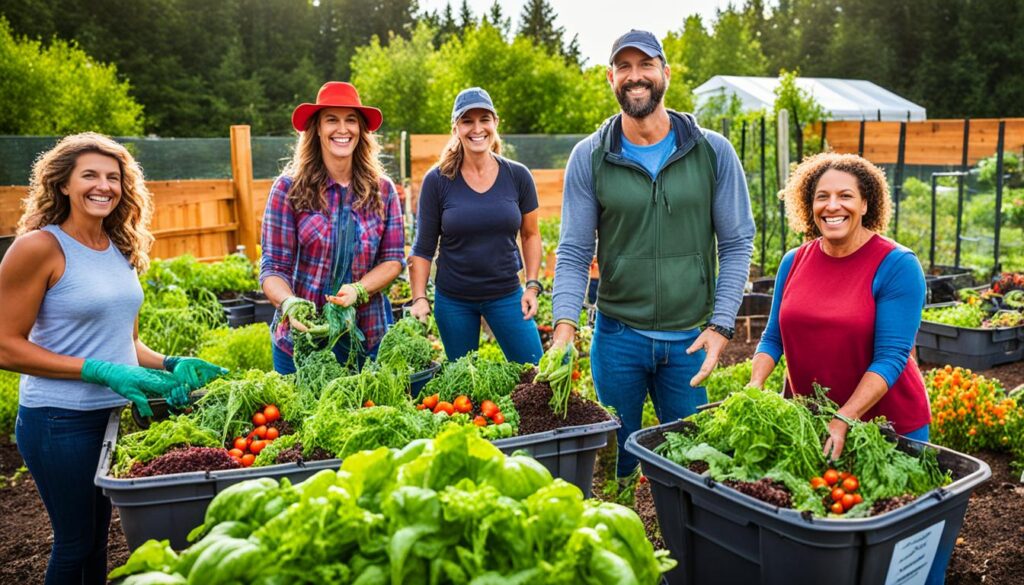
Sharing your garden’s extra food is great for everyone. It cuts down on food waste and brings happiness to those without access to fresh produce. By sharing your garden harvesting tips and sustainable gardening advice, you encourage others to help build a better food system.
The Power of Community Involvement
Being part of your community is key to sustainable food preservation and community involvement. You could help at a community garden, swap produce with neighbors, or plan a harvest festival. These actions bring people together and make us all care more about our food.
“When we come together to share our garden’s bounty, we’re not just nourishing bodies – we’re nourishing the spirit of our community.”
| Organization | Mission | How to Get Involved |
|---|---|---|
| Each Green Corner | Connecting home gardeners with food-insecure families | Donate excess produce, volunteer, or start a local chapter |
| University of California Master Gardeners Harvest for Neighbors | Harvesting and distributing surplus produce to food banks and shelters | Contact your local UC Master Gardener program to volunteer |
Sharing and getting involved in your community can really change lives. So, when your garden is full of food, think about giving some away. You’ll feel the happiness of helping others.
Garden Planning for Next Season
As the growing season ends, it’s key to plan for next year. Clean up plant debris, mulch the soil, and think about planting a cover crop to boost soil health. Looking back at this season helps you make better choices for next year, like picking the right crops and when to plant them.
Improving your gardening habits makes for a better harvest every year. Here are some tips to start:
- Check how your garden did this year. See which crops did well and which didn’t. This info helps with planning next year.
- Think about crop rotation. Switching crops helps prevent soil problems and keeps pests and diseases away.
- Try new varieties: Grow different types of your favorite veggies or add new ones to your garden.
- Plan how to store and preserve your harvest. This way, you can enjoy your garden’s produce all year.
- Use cover crops: Plant them in empty spots to make the soil better, richer, and keep it moist.
Planning ahead sets your garden up for success. This way, you can keep enjoying your garden’s rewards for many years.
| Crop | Recommended Planting Time | Preservation Method |
|---|---|---|
| Tomatoes | May-June | Canning, Freezing |
| Carrots | April-June | Root Cellar Storage |
| Spinach | March-April, September-October | Freezing |
“Successful gardening is not just about what you grow, but how you plan for the future. Take the time to learn from your past experiences and make adjustments for an even more bountiful harvest next season.”
Remember, garden planning is a continuous process. By refining your approach, you can have a sustainable, thriving garden. This way, you’ll always have fresh, nutritious produce.
Community Involvement
Sustainable gardening is more than just about your garden. It’s about building a community around your green practices. By connecting with your local community, you can make a bigger difference. You can also encourage others to grow food in eco-friendly ways.
Start by joining or leading community events like garden workdays, produce swaps, or workshops. These events let you share tips, learn from others, and meet people who care about the planet. Working with groups like food banks, schools, or community centers can help you give away extra food and teach others about preserving food sustainably.
- Organize or join community garden workdays
- Host or go to produce swaps to share your harvest
- Give workshops on sustainable gardening and food preservation
- Donate extra produce to local food banks or community programs
- Work with schools or community centers to inspire future sustainable gardeners
Building a community of sustainable gardeners helps spread the word and make a bigger difference. Your garden can bring people together, improve food access, and increase love for local food systems.
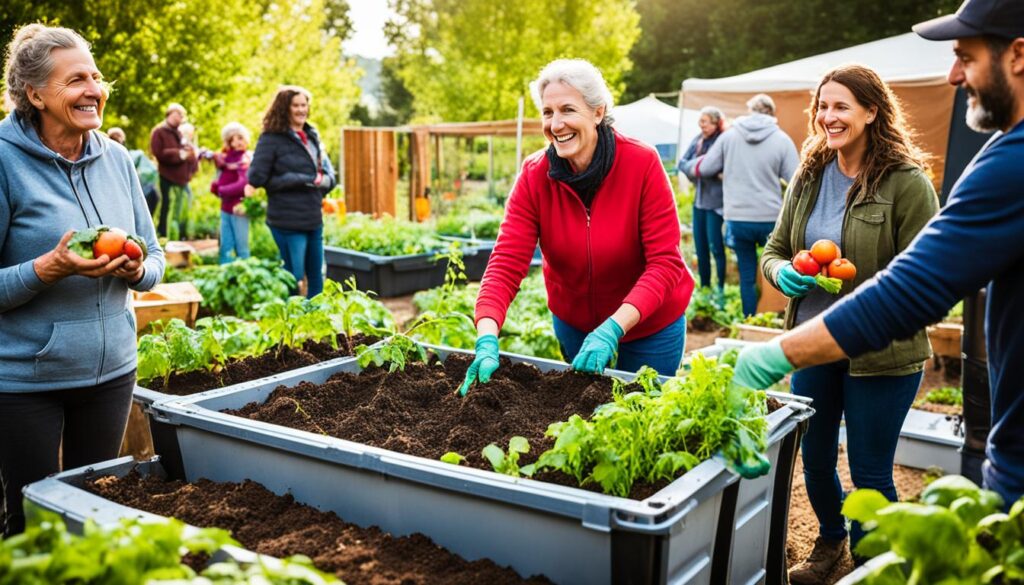
“Sustainable gardening is not just about the plants – it’s about growing a community rooted in shared values and a commitment to the environment.”
Conclusion
Sustainable harvesting is the secret to making your garden thrive. By planning and using the right techniques, you can enjoy your garden’s produce all year. Sharing your harvest with others also helps spread the joy.
Using organic pest control and cover crops makes your garden even better. It becomes a place that feeds you and helps the local environment. This makes your garden a green haven for everyone.
By gardening sustainably, you get a lot of food and help the planet. Keep up with these practices and watch your garden grow. It will show the beauty of living sustainably and the happiness of growing your own food.
Every step you take in sustainable harvesting counts. Your garden shows what you value. By taking care of it, you’re working towards a better future for your community and Earth. Keep learning, trying new things, and sharing what you know. Your garden’s harvest is a gift that keeps giving.
FAQ
How can I share my garden’s abundance with my community?
Sharing your garden’s produce with others connects you with your community and helps those in need. Donate to local food banks, shelters, or groups like Each Green Corner. They link gardeners with those who lack access to food.
What are some sustainable harvesting practices I can implement in my garden?
Use organic methods and avoid synthetic fertilizers and pesticides. Try companion planting and beneficial insects to keep your garden healthy. Properly store your harvest to reduce waste and keep your produce fresh.
How can I plan for a successful harvest in my garden?
Plan carefully for a great harvest. Think about when crops ripen, how to harvest them, and how to store them. Succession planting can give you a steady harvest instead of a huge amount all at once.
Why is it important to time my harvests correctly?
Harvesting at the right time is key. Each crop has its own signs of readiness, like color or size. Harvesting when they’re ready ensures they taste best. Use clean tools and containers to keep your produce fresh.
What methods can I use to preserve my garden’s bounty?
You can preserve your garden’s produce through canning, freezing, drying, fermenting, or pickling. Each method has its own needs and effects on taste and nutrition. Storing your harvest right can reduce waste and let you enjoy your garden’s produce all year.
How can I incorporate organic pest control methods into my sustainable gardening practices?
Use organic pest control like companion planting, beneficial insects, and natural repellents. These methods keep your garden healthy without harming the environment. They also make sure your food is safe and of high quality.
How can I plan for the next growing season based on the current year’s harvest?
Plan for next year’s garden as the season ends. Clean up, mulch, and maybe plant a cover crop to enrich the soil. Think about what worked and what didn’t this year. This will help you choose better crops and schedules for the future, ensuring a successful harvest every year.
Source Links
- https://fastercapital.com/topics/harvesting-and-preserving-your-gardens-bounty.html – Harvesting And Preserving Your Gardens Bounty – FasterCapital
- https://ucanr.edu/blogs/blogcore/postdetail.cfm?postnum=55146 – Sharing Your Garden Bounty
- https://gradesofgreen.org/program-pathway/launch-eco-lessons/launch-lessons-harvest-and-sustain-your-garden-part-4-of-4-k-5th/ – LAUNCH Lessons: Harvest and Sustain a Garden K-5th Activity
No-Dig Gardening: Benefits and How to Start
Imagine a garden that grows easily, with few weeds, and full of life. This dream is what no-dig gardening is all about. It’s changing how we garden. We’ll look at its benefits and how to begin your own easy garden.
But first, let’s ask a big question: What if the secret to a great garden is working with nature, not against it? This idea is at the heart of no-dig gardening. It’s a new way of gardening that turns old ideas upside down.
Key Takeaways
- No-dig gardening is a sustainable way to improve soil without turning it over.
- This method cuts down on work, weeds, and helps plants grow healthier naturally.
- It works like nature’s ecosystem, making gardens easy to care for and full of life.
- Using no-dig gardening can make your soil better and healthier.
- Starting with no-dig gardening, like sheet mulching, can turn your yard into a green oasis.
Embracing Nature’s Ecosystem: The Principles of No-Dig Gardening
No-dig gardening is all about understanding the soil ecosystem. It’s full of life, from fungi to earthworms and beneficial microbes. By copying nature, gardeners make their soil better and grow strong, healthy gardens.
Soil is Life: Understanding the Soil Ecosystem
Soil is alive, not just a simple ground cover. It’s a complex mix of organisms that help plants grow. These include bacteria, fungi, and microbes that are key to nutrient cycling and keeping the soil healthy. No-dig gardening helps keep this ecosystem strong, giving plants the nutrients they need.
Mimicking Nature: The Art of No-Dig Gardening
No-dig gardening follows nature’s lead. It lets organic matter break down naturally, enriching the soil. This way, the soil stays healthy and plants grow better. By not tilling the soil, gardeners keep the soil’s life and networks that plants need to thrive.
“The soil is the great connector of our lives, the source and destination of all.” – Wendell Berry
Using no-dig gardening lets you improve your soil and grow a beautiful, organic garden. This method is good for the soil and helps you connect more with the earth.
Transforming Your Garden: The Sheet Mulching Technique
Starting with no-dig gardening means using the sheet mulching technique, also known as lasagna gardening. This method layers organic materials on top of your soil or lawn. It creates a perfect environment for plants to grow well.
Layering Organic Materials: The Lasagna Gardening Approach
Sheet mulching’s success comes from layering organic materials carefully. Start with cardboard or newspaper to block light and stop weeds. Then, add a thick layer of compost for nutrients and organic matter.
Keep adding layers of organic matter, like shredded leaves, straw, or aged manure. This creates a rich environment for your plants.
Compost: The Key to a Thriving No-Dig Garden
- Compost is crucial for a no-dig garden, bringing beneficial microorganisms and improving soil structure.
- Adding compost to your layers boosts the soil’s moisture retention and nutrient cycling.
- As the organic materials break down, they increase the soil’s organic matter. This makes the soil more fertile and healthy.
“The beauty of sheet mulching is that it allows you to transform even the most challenging soil into a thriving, nutrient-rich garden bed, without the need for arduous digging or tilling.”
The Bounty of No-Dig Gardening: Reduced Weeds and Healthier Plants
No-dig gardening can change your garden for the better. It leads to fewer weeds and healthier plants. By putting a thick, rich mulch on the soil, you stop weeds from growing.
Using cardboard or newspaper helps block light, so weed seeds can’t grow. The compost adds nutrients that help your plants thrive. As your plants grow, they crowd out weeds, making the soil less welcoming for them.
This means your garden will have healthier plants, fewer weeds, and richer soil. No-dig gardening lets you focus on your plants, not fighting weeds. It’s a way to take back your garden.
| Benefits of No-Dig Gardening | Traditional Tilling | No-Dig Approach |
|---|---|---|
| Weed Suppression | Frequent manual removal required | Thick mulch layer smothers weeds |
| Soil Fertility | Disrupts soil structure, depletes nutrients | Compost and organic matter enrich the soil |
| Plant Health | Vulnerable to pests and diseases | Thriving root systems and microbial communities |
Try no-dig gardening and see how your garden changes. You’ll have fewer weeds, healthier plants, and soil full of life. This sustainable method brings big rewards.
Unleashing Nature’s Power: The Ecosystem Engineers at Work
No-dig gardening thrives thanks to the many creatures in the soil ecosystem. These heroes, like worms, insects, and microbes, work hard to keep your garden’s soil healthy.
The Unsung Heroes: Worms, Insects, and Microbes
Worms are key “ecosystem engineers.” They dig tunnels, letting air and water deep into the soil. Their waste, or castings, adds nutrients and improves soil.
Insects, like beetles and ants, are vital too. They break down organic matter and release nutrients for plants. Many insects also eat pests, keeping your garden balanced.
Underground, microbes like bacteria and fungi are busy. They turn organic stuff into nutrients for plants. They also help soil structure and support beneficial fungi that help plants grow.
| Organism | Role in the Soil Ecosystem |
|---|---|
| Worms | Aerate soil, improve structure, and provide nutrient-rich castings |
| Insects | Decompose organic matter, prey on pests, and maintain balance |
| Microbes | Break down organic materials, release nutrients, and improve soil structure |
Supporting these “ecosystem engineers” makes your no-dig garden thrive. It becomes a self-sustaining system that gives you lots of healthy, nutrient-rich food.
No-Dig Gardening: A Sustainable Solution for Thriving Gardens
Embracing sustainable gardening, no-dig gardening is an eco-friendly way to grow gardens. It reduces soil disturbance and uses natural processes. This method helps with carbon sequestration and climate change mitigation. It also makes gardens more fertile and resilient to drought and extreme weather.
No-dig gardening sees soil as a living ecosystem full of microorganisms, insects, and worms. By keeping this balance, gardeners create a self-sustaining garden. This method needs less fertilizers and pesticides, helping plants and the environment.
- Reduced carbon footprint: No-dig gardening cuts down soil disturbance, which traps carbon in the soil and fights climate change.
- Improved soil health: It boosts the soil’s natural fertility, making it better at holding water and providing nutrients for plants.
- Increased biodiversity: The undisturbed soil is a great home for beneficial organisms, creating a balanced garden ecosystem.
No-dig gardening is a sustainable way to make gardens lush, productive, and good for the environment. By using this method, you help your soil, plants, and the planet.
“Sustainable gardening is not just about growing food or flowers – it’s about nurturing the entire ecosystem and leaving the land in a better state than we found it.”
| Benefits of No-Dig Gardening | Traditional Gardening |
|---|---|
| Improved soil structure and fertility | Soil degradation and loss of organic matter |
| Increased water-holding capacity and drought resilience | Higher irrigation and water usage |
| Enhanced biodiversity and ecosystem balance | Disruption of natural habitats and reduced biodiversity |
| Lower carbon footprint and climate change mitigation | Higher carbon emissions and contribution to climate change |
Nurturing the Soil, Nurturing Yourself: The Mental and Physical Benefits
No-dig gardening offers more than just practical benefits. It can deeply affect your mental and physical health. Caring for a garden can make you feel closer to nature. It encourages mindfulness and stress relief. Plus, it’s a great way to get some exercise.
Gardening is good for your mental health. Digging, planting, and weeding can make you focus on the now. This helps reduce anxiety and makes you feel happier.
Gardening also boosts your physical health. The exercise and sunlight can improve your heart health, muscle strength, and flexibility. Eating fresh produce from your garden can make your diet more varied and tasty. This supports your overall well-being.
“Gardening is the purest of human pleasures.” – Francis Bacon
Choosing no-dig gardening helps you grow a beautiful garden and a strong connection to nature. Taking care of the soil helps your mental and physical health. It makes gardening a rewarding and refreshing activity.
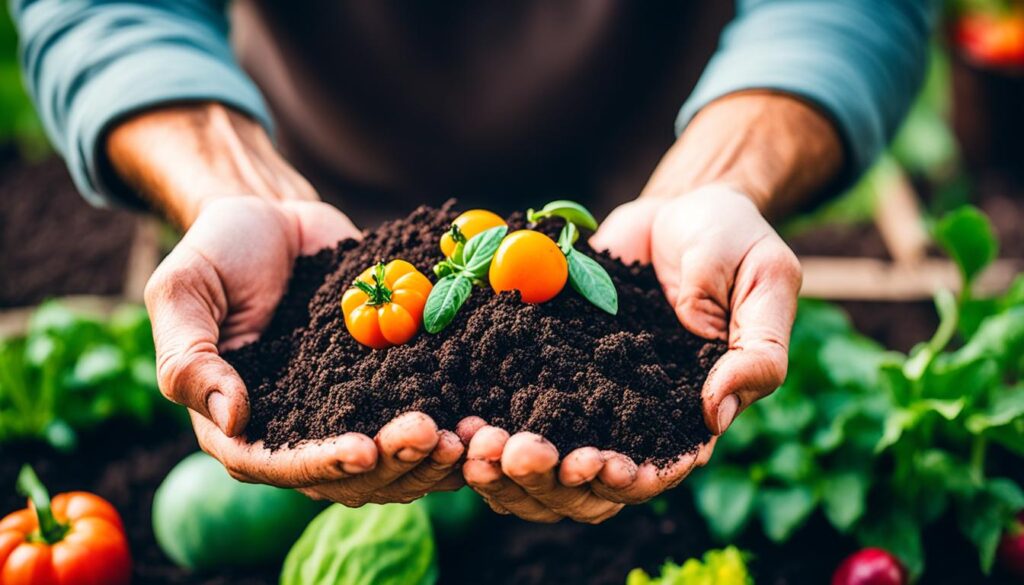
no-dig gardening: A Low-Maintenance Approach to Gardening Bliss
Embracing no-dig gardening means saying goodbye to hard gardening tasks. This new way of gardening saves your time and energy. It lets you enjoy the best parts of gardening.
No-dig gardening is easy to keep up with. You don’t need to till, weed, or lift heavy things often. This makes your garden a beautiful place with little work needed to keep it looking great. The mulch stops weeds, and the soil works hard on its own, needing almost no help from you.
| Benefits of No-Dig Gardening | Traditional Gardening |
|---|---|
| Reduced effort and time investment | Constant weeding, tilling, and manual labor |
| Healthy, nutrient-rich soil | Depleted, compacted soil |
| Thriving, low-maintenance plants | Struggling, high-maintenance plants |
Join the effortless gardening movement and find the real bliss of a low-maintenance, time-saving garden. Start with no-dig gardening and turn your outdoor area into a lush, lively space with little work.
“No-dig gardening is the ultimate in low-maintenance and reduced effort gardening. It’s a true time-saving and effortless way to create a thriving, productive garden.”
Seasonal Transitions: Adapting No-Dig Gardening to Your Climate
No-dig gardening works well in many climates. As seasons change, simple tweaks can keep your garden thriving all year. Whether you’re getting ready for spring or enjoying summer’s harvest, these tips will help your no-dig garden flourish.
Spring Awakening: Preparing Your No-Dig Garden
When spring comes, wake up your garden gently. Start by adding compost to your beds to make the soil rich and ready for new growth. Watch out for any frost in your area and protect your seedlings. With some prep work, your garden will be ready for a great spring harvest.
Summer Abundance: Reaping the Rewards of No-Dig Gardening
Summer is a time to celebrate in your no-dig garden. The organic layers you built up will help keep the soil moist and weed-free. This lets you enjoy your garden’s bounty without much work, enjoying the harvests your garden provides.
No matter the season, no-dig gardening is a sustainable way to grow your dream garden. By using seasonal adaptations and climate-specific techniques, your no-dig beds will do well from spring preparation to summer harvests.
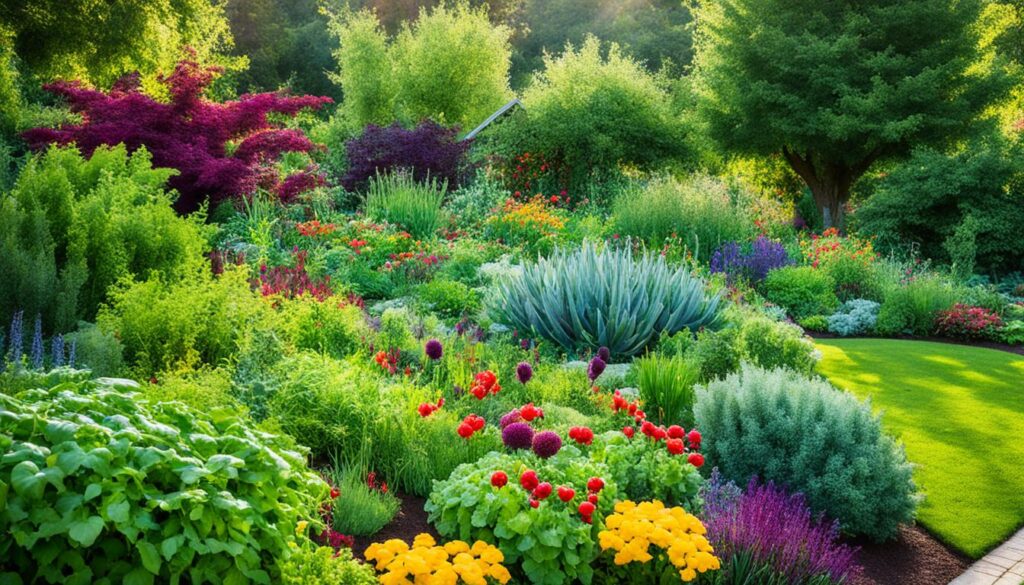
Conclusion: Embracing a New Gardening Philosophy
No-dig gardening changes how you grow food and plants. It means working with nature instead of fighting it. This way, you get gardens that are healthy, easy to care for, and good for the planet.
This method makes you connect more with nature and live more sustainably. It leads to lots of food and a stronger bond with the earth. It’s a new way of gardening that’s good for you and the planet.
Switching to no-dig gardening means using practices that help the soil’s ecosystem. You’ll see your garden do well without needing a lot of work. This approach makes you a caretaker of the earth, enjoying the mental and physical perks of a beautiful garden.
Starting with no-dig gardening is a journey of learning and wonder. You’ll see how nature’s design is beautiful and strong. By going this way, you’ll change your garden and gain a new respect for all living things. Start this path and see the amazing results of a sustainable garden oasis.
FAQ
What is no-dig gardening?
No-dig gardening enriches the soil without digging. It uses compost on top to reduce weeds and labor. This method copies nature, where organic stuff breaks down into nutrient-rich soil by worms, insects, and microbes.
What are the key benefits of no-dig gardening?
No-dig gardening has many benefits. It reduces weeds, makes plants healthier, and improves soil structure. It’s also sustainable and easy to maintain.
How does no-dig gardening work?
It’s based on soil being a living ecosystem. By copying nature, like forests and meadows, no-dig gardening avoids the harm from tilling.
What is the foundation of no-dig gardening?
The foundation is sheet mulching, or lasagna gardening. It layers cardboard, newspaper, and compost on the soil or lawn.
How does no-dig gardening suppress weed growth?
A thick, rich mulch layer on the soil surface stops weeds. Cardboard or newspaper blocks light, and compost helps good plants grow.
What role do soil organisms play in no-dig gardening?
Soil organisms are key to no-dig gardening’s success. Worms, insects, and microbes break down organic matter, aerate the soil, and cycle nutrients.
How does no-dig gardening align with principles of sustainability?
It’s sustainable and good for the environment. It cuts down on soil disturbance and uses natural processes to keep soil fertile. This reduces gardening’s carbon footprint and fights climate change.
What are the mental and physical benefits of no-dig gardening?
Gardening can make you feel connected to nature and reduce stress. It’s a way to stay active and enjoy fresh, healthy food.
What is the low-maintenance nature of no-dig gardening?
No-dig gardening is easy to keep up with. It doesn’t need regular tilling, weeding, or heavy lifting. This lets gardeners enjoy the fun parts of gardening more.
How can no-dig gardening be adapted to different climates?
No-dig gardening works in many climates. In spring, add compost to beds and watch for frost. In summer, the mulch keeps soil moist and weeds down.
Source Links
- https://www.charlesdowding.co.uk/post/the-amazing-benefits-of-no-dig-no-till – The amazing benefits of no dig, no till
- https://www.saveur.com/culture/no-dig-gardening/ – I (Basically) Stopped Weeding Thanks to This Game-Changing Gardening Method
- https://www.bhg.com/gardening/how-to-garden/no-dig-gardening/ – How a No-Dig Garden Leads to Healthier Soil and Thriving Plants
Edible Landscaping: Beautiful and Functional Garden Spaces
Imagine turning your yard into a vibrant, productive oasis. A place where beauty and function come together. Welcome to edible landscaping, where tasty fruits, veggies, and herbs meet beautiful plants. How can you mix the practical with the pretty for a stunning edible landscape?
Edible landscaping is about putting edible plants in your outdoor space. It lets you have a garden that looks great and gives you fresh food. By doing this, you make your garden a true reflection of your style and tastes. It also helps the planet and makes you more self-sufficient.
Key Takeaways
- Edible landscaping blends ornamental and edible plants for a visually appealing and productive garden
- It allows homeowners to engage in micro-farming and connect with nature while creating stunning outdoor spaces
- Edible landscaping promotes sustainability, self-sufficiency, and environmental responsibility
- Integrating edible plants into your landscape design can enhance the overall aesthetic appeal of your property
- Edible landscaping offers a unique opportunity to personalize your outdoor living space and reflect your culinary preferences
Embracing Edible Landscaping
More suburban residents are turning to edible landscaping as professional farmers decrease in the U.S. This shift shows a growing need to reconnect with nature, cut down on food miles, and control where our food comes from. Edible landscaping brings many benefits like more biodiversity, less carbon footprint, and the joy of eating homegrown food.
The Rise of Suburban Micro-Farming
Homeowners can make their yards into productive, green spaces by adding edible plants. This move towards urban farming and sustainable gardening is about more than just growing food. It’s also about building community and caring for the environment.
The Benefits of an Edible Landscape
Choosing edible landscaping brings many perks for people, communities, and the earth. It cuts down on carbon emissions and lets you taste the freshness of your own food. These spaces combine beauty with usefulness, supporting environmental benefits and deepening our love for nature.
“Edible landscaping transforms ordinary yards into productive, eco-friendly havens that nourish both body and soul.”
Integrating Edibles into Your Landscape Design
Creating an edible landscape needs careful planning for a beautiful look. Start with edible foundation plantings like currant bushes or dwarf fruit trees. They can replace traditional shrubs.
These plants offer food and add beauty to your landscape. Mixing different colors, textures, and shapes of edible plants makes your garden look great.
Simplicity: Edible Foundation Plantings
Choose and group edible foundation plants for their looks. This way, you get a garden that’s useful and pretty. These plants blend into your landscape, offering food and beauty.
Unifying Elements: Color, Texture, and Shape
When adding edible plants to your landscape, focus on color coordination, texture, and plant form. Pick plants with matching colors, different textures, and various shapes. This makes your garden look unified and beautiful.
| Edible Plant | Color | Texture | Plant Form |
|---|---|---|---|
| Blueberry | Blue-green foliage, blue berries | Smooth, waxy leaves | Compact, mounding habit |
| Swiss Chard | Vibrant red, yellow, or white stems | Broad, crinkly leaves | Upright, mounding growth |
| Kale | Deep green, purple, or red-tinged leaves | Textured, waxy leaves | Upright, rosette form |
By picking edible plants that look good together, you can make a beautiful edible garden. It will be both useful and pretty.
Edible Landscaping: A Softer, Gentler Approach
Choosing natural landscaping and low-maintenance gardening makes your garden more interactive. It’s different from the usual neat lawns. An edible landscape lets you connect closely with your garden and nature’s cycles.
Forget the boring work of cutting grass. An edible garden brings the joy of picking fresh food right from your yard. This change helps you see nature’s beauty and its cycles in a new way.
“Edible landscaping is about creating a symbiotic relationship between humans and the environment, where we work in harmony with nature rather than against it.”
Adding edible plants to your garden makes it look great and gives you lots of food. This way of gardening is fun and teaches you about nature.
Going for a soft, natural look in your garden turns it into a peaceful spot. Here, you can connect with the land, nourish your body, and enjoy the simple joys of low-maintenance gardening.
Creating Visual Interest with Edible Plants
Edible plants can make your garden stand out. By using fruit trees, edible hedges, and edible focal points, you can make your garden both pretty and full of food. This approach makes your garden a feast for the eyes and the taste buds.
Showcase Trees: Fruit Trees as Focal Points
Fruit trees like cherry or dwarf apple trees are great edible focal points. They bring life with their flowers, leaves, and lots of fruit. They add fun and beauty to your garden. Putting a fruit tree in the middle can make your garden look amazing.
Living Privacy Screens with Edible Hedges
Edible hedges made of currants, raspberries, or ornamental grasses can be both pretty and useful. They give you privacy and add interesting textures and colors to your garden. These edible privacy screens make your garden look great and work well.
| Edible Plant | Visual Appeal | Functionality |
|---|---|---|
| Cherry Tree | Stunning spring blooms, vibrant summer foliage, and delicious red cherries | Serves as a focal point and provides a bountiful harvest |
| Raspberry Hedge | Lush green foliage, delicate pink flowers, and juicy red raspberries | Creates a privacy screen and yields a tasty crop |
| Ornamental Grass Hedge | Graceful, swaying movements and textural interest | Provides privacy and can be edible, such as lemongrass |
By thoughtfully placing these edible plants in your garden, you can create a space that’s both useful and beautiful. It’s a mix of function and beauty that’s sure to please.
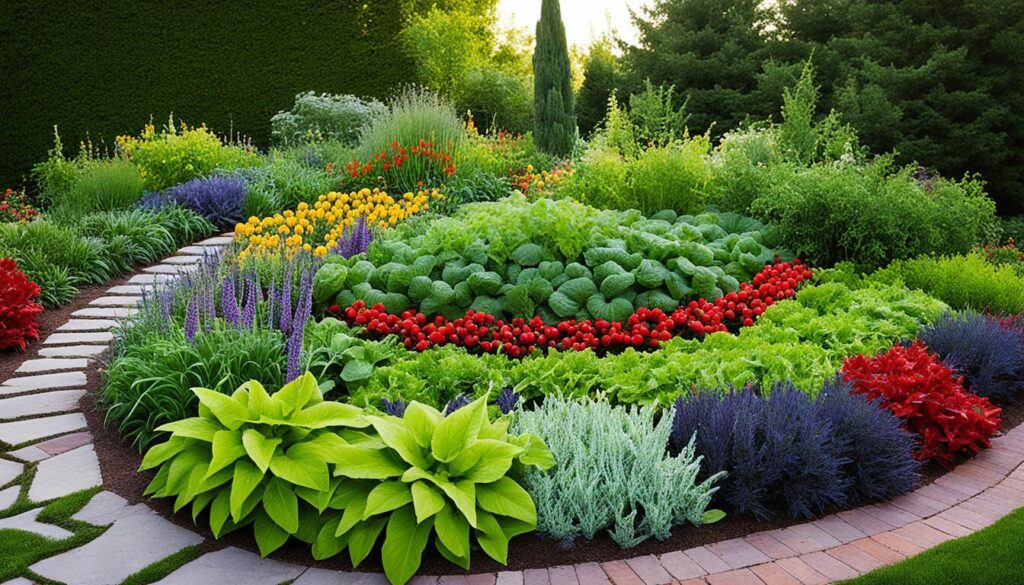
“Edible landscaping allows you to create a beautiful, productive garden that nourishes both the body and the soul.”
Incorporating Vegetables and Herbs
Make your garden look better and taste better by adding edible vegetables and herbs to your design. If you have little space, consider using raised beds or containers for your small-space gardening needs.
Raised Beds and Containers for Small Spaces
Using raised or confined spaces saves space and looks good in the garden. They make your garden look better and work well for small-space gardening. By picking the right edible vegetables and edible herbs, you can make your garden both useful and pretty.
- Raised beds have better drainage, soil, and are easy to get to. They’re perfect for small-space gardening.
- Container gardening lets you grow your own edible vegetables and edible herbs in small spots like balconies or patios.
“Integrating edibles into your landscape design can transform your garden into a bountiful oasis of flavor and beauty.”
With raised beds and containers, you get a garden that looks great and gives you fresh produce. Enjoy the best of both worlds – a beautiful garden and fresh food right at home.
Designing Your Edible Landscape
Creating a beautiful and useful edible garden takes planning and thought. Using 3D design software helps a lot. It lets homeowners see their garden’s layout, try out plant setups, and make sure plants get enough sun and water.
Grouping plants by their needs is also key. This means putting plants that like the same sunlight, water, and nutrients together. By doing this, you make a garden that works well and looks great. This is called companion planting and plant grouping.
Utilizing 3D Design Software for Planning
3D design software is a big help for planning your garden. It lets you see how different plants will look together and where they’ll get the most sun. This tech makes planning your garden fun and interactive.
Grouping Plants Based on Needs
It’s important to group plants that need the same things together. This makes your garden work better and look better. Plants that grow well together help each other out, making your garden healthy and beautiful.

“Thoughtful design is the key to transforming your yard into a bountiful and beautiful edible landscape.”
By planning carefully, you can make your garden both pretty and useful. Using 3D design software and grouping plants based on their needs are great ways to make a garden that’s full of life and looks great.
| Feature | Benefit |
|---|---|
| 3D Design Software | Allows for visualization, experimentation, and optimization of plant placement and sun exposure |
| Companion Planting | Promotes a harmonious and self-sustaining ecosystem by grouping plants with similar needs |
| Strategic Plant Grouping | Enhances the aesthetic appeal and productivity of the edible landscape |
Eco-Friendly Pest Management
Creating a lush edible garden means focusing on eco-friendly pest control. Instead of using harsh chemicals, you can use natural methods. These are safe for your family and the planet, and they help keep your garden healthy.
Natural Pest Deterrents in the Edible Landscape
Using organic pest control and natural pest deterrents in your garden can keep pests away safely. Here are some eco-friendly gardening tips:
- Plant geraniums or marigolds with your vegetables to keep aphids and whiteflies away.
- Add ladybugs and lacewings to your garden to eat pests.
- Use neem oil or diatomaceous earth to control pests safely.
- Grow many different plants to keep pests away and make your garden healthy.
Choosing organic pest control methods keeps your edible landscape healthy. It also supports sustainable gardening.
“Eco-friendly pest management is not only better for the environment, but it also helps create a healthier, more vibrant edible landscape that you can truly enjoy.”
Harvesting and Enjoying Your Edible Landscape
Having an edible landscape is very rewarding. You get to pick and enjoy fresh produce like juicy berries, crisp vegetables, and fragrant herbs. This can give you a steady supply of tasty, healthy food. You can also use different ways to keep your homegrown food fresh for longer. This lets you enjoy the tastes of your edible landscape all year.
Preserving your fresh produce is a great way to keep enjoying its flavors even after the growing season ends. You can use canning, freezing, or drying to keep your edible landscape harvest fresh. This turns your hard work into delicious, long-lasting foods. With some planning, you can enjoy your harvest all year.
Enjoying your edible landscape is easy. You can snack on fresh berries, make salads with your own greens, or preserve the season’s produce. By growing different edible plants, you turn your outdoor space into a lush garden. This garden feeds your body and soul.
Conclusion
Edible landscaping changes how you see your garden. It turns it into a place that looks great and gives you fresh food. By mixing plants that look good and those that you can eat, you get the best of both worlds. This way, you have a beautiful garden that also gives you lots of fresh, healthy food.
This approach to gardening is good for the planet and brings people together. It makes you feel closer to the earth and to your neighbors. More people are starting to love this way of gardening, making their yards into beautiful, useful spaces.
Edible landscaping is more than just a trend. It’s a way to live better, be more self-sufficient, and enjoy your garden more. By making your own edible garden, you help your community and get to enjoy the beauty and benefits of your garden.
FAQ
What is edible landscaping?
Edible landscaping mixes pretty plants with food plants in a beautiful way. It turns yards into places that look good and produce food. You can grow fruits, veggies, and herbs that look great together.
Why is edible landscaping becoming more popular?
More people like edible landscaping because it lets them grow their own food and enjoy nature. It’s a way to make gardens look amazing and eat fresh, local food. It also helps people feel connected to the earth and in control of their food.
What are the benefits of an edible landscape?
Edible landscapes are good for the planet and for you. They bring more life to your garden, cut down on pollution, and let you eat food you grew yourself. They encourage a caring way of gardening that values nature’s health.
How can I integrate edible plants into my landscape design?
To add edible plants to your garden, plan carefully for a look you’ll love. Use different types of plants for color, texture, and shape. Group them by how they look and grow to make your garden beautiful and easy to care for.
How can I create visual interest with edible plants?
Edible landscaping can make your garden look amazing. Use fruit trees as eye-catchers and edible hedges for privacy. Placing these plants thoughtfully makes your garden both useful and beautiful.
How can I incorporate vegetables and herbs into my landscape design?
Adding veggies and herbs to your garden brings color and flavor. Use raised beds or containers to grow more in small spaces. This adds beauty and structure to your garden.
How can I ensure the health and sustainability of my edible landscape?
Keep your edible garden healthy by using safe ways to keep pests away. Use plants like geraniums or marigolds to keep bugs away naturally. This helps your garden stay healthy and beautiful.
How can I enjoy the harvests from my edible landscape?
Harvesting from your edible garden is very rewarding. You can eat your fresh produce right away or preserve it for later. Techniques like canning, freezing, or drying let you enjoy your garden’s flavors all year.
Source Links
- https://backyard-eats.com/ – Home | Backyard Eats
- https://www.tenthacrefarm.com/see-how-easily-you-can-create-an-edible-landscape/ – See How Easily You Can Create an Edible Landscape
- https://frisellanursery.com/designing-an-edible-landscape-the-perfect-blend-of-functionality-and-aesthetics/ – Designing an Edible Landscape: The Perfect Blend of Functionality and Aesthetics
Permaculture Principles for a Sustainable Garden
Ever thought about turning your backyard into a lush, green haven? The secret is in permaculture, a way to use nature’s power for sustainable gardens. But what are these principles, and how do they make your garden stand out?
Key Takeaways
- Permaculture is a holistic design approach that mimics natural ecosystems to create sustainable and resilient systems.
- The three core ethics of permaculture are care for the earth, care for people, and fair share.
- The 12 permaculture design principles offer a comprehensive framework for planning and designing a thriving, low-maintenance garden.
- Applying permaculture principles can transform your outdoor space into a self-sustaining, eco-friendly oasis.
- Permaculture gardening promotes biodiversity, conserves resources, and helps you live in harmony with nature.
Understanding Permaculture
Permaculture is a way to design systems that are sustainable and self-sufficient. It combines “permanent” and “agriculture” to make ecosystems that work well together. The core of permaculture has three main ethics: care for the earth, care for people, and fair share. These ethics guide the 12 design principles used in permaculture. These principles help create gardens and landscapes that are full, resilient, and good for the planet.
The Foundations: Ethics and Design Principles
The three main ethics of permaculture are people care, earth care, and fair share. They guide all decisions and actions in permaculture. These ethics lead to the 12 design principles that help create sustainable systems:
- Observe and Interact
- Catch and Store Energy
- Obtain a Yield
- Apply Self-Regulation and Accept Feedback
- Use and Value Renewable Resources
- Produce No Waste
- Design from Patterns to Details
- Integrate Rather Than Segregate
- Use Small and Slow Solutions
- Use and Value Diversity
- Creatively Use and Respond to Change
- Cooperate, Not Compete
Using these principles, permaculture design can make sustainable gardens, organic farms, and eco-friendly living spaces. These systems work well with nature.
Observe and Interact
The core of permaculture is “Observe and Interact.” It tells you to watch your garden closely and learn about its natural ways. By noticing things like sunlight, wind, water, and the local climate, you can make your garden fit right in with the land.
Starting with nature observation is key in permaculture. It helps you make smart choices and align your garden with the ecosystem. This method is crucial for permaculture design. It lets you use nature’s patterns and rhythms to your advantage.
Unlock the Secrets of Your Site
Start by really looking at your garden or outdoor area. Notice these things:
- Sunlight patterns – Where does the sun shine during the day, and how does it change with the seasons?
- Wind direction and intensity – How does the wind move through your space, and what might affect it?
- Water movement – Where does water gather, flow, or drain, and how can you use it?
- Microclimates – Are there spots that are protected or exposed, changing the temperature and moisture?
By really watching these patterns, you can design your garden to match your site’s natural traits. This makes your permaculture system stronger and more fruitful.
“The first step in the permaculture design process is to observe and interact with the land. This allows you to understand the natural patterns and relationships present, and design your garden accordingly.”
Following “Observe and Interact” is vital in permaculture design. By using nature’s patterns, you can make a garden that’s sustainable, strong, and does well with the local ecosystem.
Catch and Store Energy
In permaculture, “Catching and Storing Energy” is crucial. It means using and saving natural resources like water, sunlight, and wind. This helps create systems that don’t need outside help.
Rainwater harvesting is a key strategy. It collects rainwater when it’s plentiful for use later. This cuts down on the need for city water and helps during dry times.
Using renewable energy sources is also vital. Solar panels, wind turbines, or small hydro systems give power without harming the planet. They make your garden less dependent on the grid and lower your carbon footprint.
Passive solar design uses the sun’s warmth and light. By placing things right, you can get more sunlight and use less energy for heating or cooling. This makes your garden more sustainable.
“The essence of permaculture is to catch and store as much energy as possible.” – Bill Mollison, co-founder of the permaculture movement.
By using these methods, permaculture gardeners make gardens that are strong and self-sufficient. The “Catch and Store Energy” idea is key to a sustainable garden. It helps you take care of the land and support renewable resources.
Obtain a Yield
As a permaculture gardener, your main goal is to make your garden as productive as possible. The idea of “Obtain a Yield” means designing your garden to give you lots of useful things. This could be food, fiber, or other valuable items. By using nature’s power and techniques like companion planting and smart space use, you can boost your garden productivity. This way, you get obtaining yields that are good for the planet and rewarding for you.
Maximizing Garden Productivity
Permaculture gardening techniques focus on building a diverse, connected system like nature’s own. By planting different types of plants, each with its own role, you create a healthy garden. This method, called polyculture, cuts down on the need for extra help, fights pests and diseases, and leads to a bigger harvest.
- Use companion planting to help plants work well together, like pairing plants that fix nitrogen with those that need a lot of nutrients.
- Grow a mix of annual and perennial crops for a steady supply of fresh food all season.
- Make the most of vertical space by training vines on trellises or using raised beds to fit more plants in.
By following permaculture and aiming for obtaining yields from your garden, you can make a sustainable, productive garden. This way, you’ll have a rich harvest every year.
Apply Self-Regulation and Accept Feedback
At the core of permaculture is the idea of self-regulation and accepting feedback. As a gardener, you must be ready to see how your actions affect your garden. You should also be open to the lessons your garden teaches you.
Permaculture design is a continuous process, not just a quick fix. By self-regulating and listening to feedback from your garden, you can keep improving your methods. This makes your garden more resilient and sustainable.
- Observe your garden closely: Pay attention to how your plants, soil, and overall ecosystem are responding to your management techniques.
- Identify any negative impacts or unintended consequences: Be honest about areas where your design or actions may be causing harm, imbalance, or inefficiency.
- Adjust your permaculture design adjustments accordingly: Use the feedback from your garden to make informed decisions and modify your approach.
This cycle of watching, evaluating, and changing is crucial for a thriving garden. By using self-regulation and accepting feedback, you can make your permaculture garden harmonious, resilient, and productive.
| Principle | Description | Benefits |
|---|---|---|
| Self-Regulation | Continuously monitoring and adjusting your garden practices based on observed results. | Promotes ongoing improvement, adaptability, and long-term sustainability. |
| Accepting Feedback | Being open to learning from the land and the natural systems within it. | Allows for fine-tuning of the permaculture design to address issues and enhance resilience. |
“The true test of a garden’s success is not what it looks like, but how it behaves over time.”
By embracing self-regulation and accepting feedback, you can make your permaculture garden evolve and get better over time. It will adapt to the unique needs of your local environment.
Use and Value Renewable Resources
In permaculture gardening, sustainability is key. We focus on using things that can be replaced or reused. This includes solar power, wind energy, and organic matter for composting.
Using non-renewable resources less helps our gardens be more self-sustaining. It makes them better for the planet. And it ensures your permaculture garden will last a long time.
Sustainable Materials and Energy Sources
Think about these sustainable materials and energy sources for your garden:
- Solar panels to use the sun’s power for electricity
- Wind turbines to use wind energy for power
- Composting bins to turn waste into garden soil
- Rainwater harvesting systems to save water for your garden
- Reclaimed or recycled materials for garden structures and paths
Adding these renewable resources to your garden makes it more energy-efficient and sustainable. It works well with nature.
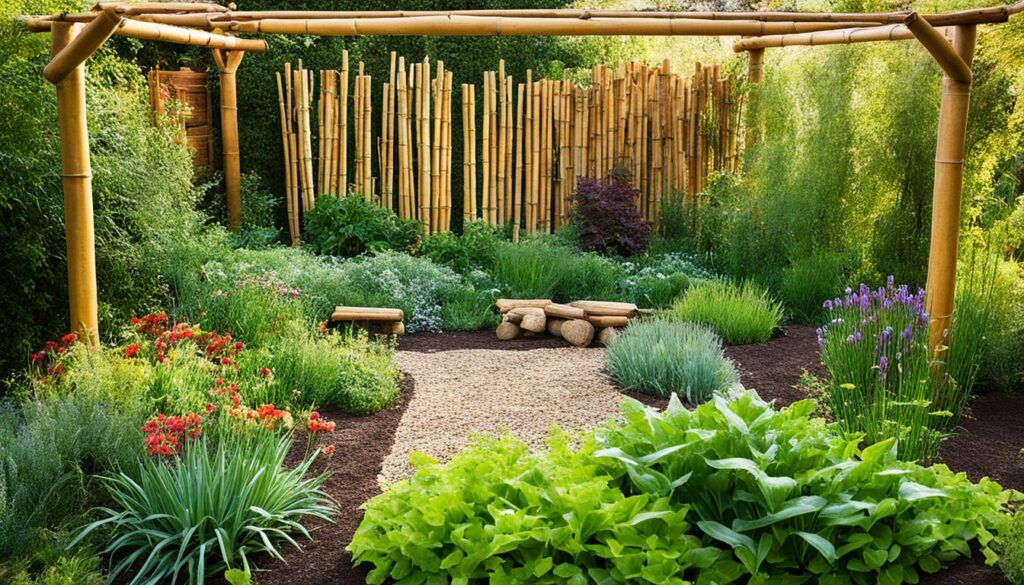
“The true cost of anything is the amount of life you exchange for it.” – Bill Mollison, co-founder of the permaculture movement
Produce No Waste
In permaculture, “Produce No Waste” is a key idea. It helps create gardens that use every resource wisely. By thinking about waste, gardeners make their gardens efficient. They use and recycle everything they can.
Closing the Loop: Reuse and Recycle
This idea is about closing the loop of resources. Gardeners don’t throw away valuable stuff. They find new uses for it in their gardens. This way, they use everything from food scraps to cardboard, making their gardens better.
Permaculture recycling is a big part of this. Turning food waste into compost helps the garden grow. Using rainwater or grey water also saves resources and cuts down on waste.
Thinking like a circular economy helps gardens be self-sustaining. Nothing is wasted, making the garden better for the environment and more productive. This follows the permaculture idea of “Obtain a Yield.”
“The true measure of a civilization is not the height of its skyscrapers, but the depth of its commitment to the wellbeing of its people and the planet.” – Permaculture Principle
Starting your permaculture journey means following “Produce No Waste.” Let your garden show how zero waste and resource conservation can work with nature.
Design from Patterns to Details
In the world of permaculture, gardeners start with big patterns and then focus on details. This means looking at the natural patterns in a landscape and designing your garden zoning to fit them. By focusing on the big picture and then the details, you make a garden that feels natural and connected to nature.
The permaculture design process is about seeing how everything in nature is connected. Instead of forcing a design, you let the land show you its natural flow. This way, you can group plants in zones and arrange things to work better together, making your garden more efficient and productive.
“The best way to predict the future is to design it.” – Buckminster Fuller
By looking at patterns in nature and using them in your garden, you make a place that takes care of itself. Your garden becomes a living work of art, where everything helps the garden thrive. This is what permaculture is all about – making gardens that feed you and the planet.
When you start your permaculture design process, think big. Look at the patterns and relationships in nature. Let these insights help you design a garden that’s in tune with the world around you. This way, you’ll make the most of your outdoor space and have a garden that’s sustainable, full of life, and beautiful for years.
permaculture gardening
Permaculture gardening is a way to make your outdoor space beautiful, sustainable, and full of life. It uses permaculture gardening principles to create a garden that works like nature. This means your garden will be a thriving ecosystem.
Key techniques include polyculture planting, composting, and using rainwater and renewable materials. These methods help grow many different, healthy crops. They also reduce the need for outside help and waste, making your garden better for the planet.
By using organic gardening and sustainable gardening methods, your garden will be lovely and support nature. It will attract pollinators, cut down on carbon emissions, and use resources wisely.
Permaculture gardening is about careful planning and respecting nature. It helps you create a garden that is strong and full of life. Learn how to use permaculture to make your garden amazing.
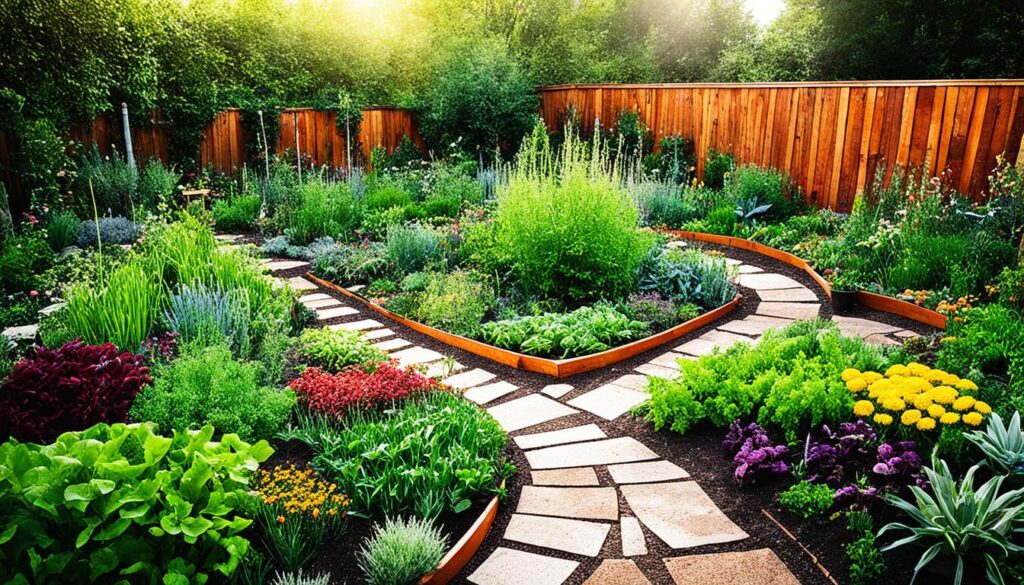
Use Small and Slow Solutions
In permaculture gardening, patience and slow steps are key. The idea of “small and slow solutions” means starting small and growing your garden over time. This way, you can make a garden that’s strong, flexible, and connected to the earth.
Slow gardening is all about taking things at a good pace. It’s about making changes step by step, not rushing. This way, you learn more about your garden and grow patience for the changes it goes through. This patience is key for a garden that lasts.
Gradual Garden Development
Permaculture gardeners know that waiting is rewarded. By using small-scale solutions and growing your garden slowly, you can make a beautiful, diverse garden. It might take time, but the benefits are big and rewarding.
“The true meaning of life is to plant trees, under whose shade you do not expect to sit.”
– Nelson Henderson
The real value of slow gardening isn’t in quick results. It’s in the lasting effects we have on the earth. With permaculture patience, you create a garden that keeps thriving, even after you’re gone.
| Principle | Description |
|---|---|
| Small and Slow Solutions | Embrace a gradual, incremental approach to garden development, rather than seeking quick fixes or drastic transformations. This fosters resilience, adaptability, and a deeper connection to the land. |
| Permaculture Patience | Cultivate a mindset of patience and appreciation for the process, understanding that sustainable change takes time to unfold and that the true rewards lie in the lasting impact on the land. |
| Gradual Garden Development | Build your garden step-by-step, starting small and gradually expanding your knowledge and skills. This allows the ecosystem to develop organically and ensures a more resilient, adaptable landscape. |
Use and Value Diversity
Permaculture gardening is all about embracing life’s diversity. By growing many plants, animals, and organisms, your garden becomes strong and productive. It’s like a mini-nature world.
Choosing a variety of crops and companion plants helps your garden’s biodiversity. This makes your garden healthier and more stable. It fights pests, diseases, and tough weather.
Polycultures: The Power of Diversity
Polycultures are key to using diversity well. They mean growing many plant types together. This approach offers big benefits, like:
- Improved ecological resilience by fighting pests and diseases
- Boosted biodiversity by supporting more plant and animal life
- A wider permaculture plant selection for a varied and healthy harvest
- Smart use of resources like light, water, and nutrients
Polycultures make your garden thrive and sustain itself. They celebrate nature’s beauty and balance.
The more diverse your permaculture garden, the stronger and more productive it gets. Let’s plan for a future full of life and variety!
Conclusion
By using permaculture, you can make your outdoor area a place that feeds itself and helps the environment. This method lets you live in harmony with nature, reduce waste, and build strong systems that can change with the times.
With methods like watching nature, collecting rainwater, growing many different plants, and moving forward slowly, you can create a garden that gives a lot of food and is good for the planet. By following permaculture, you help make a better future for your area and Earth.
Permaculture gardening has many benefits, like permaculture gardening benefits, sustainable living, and eco-friendly landscaping. Start this holistic way of living and move towards a life that is strong, independent, and caring for the earth.
FAQ
What is permaculture?
Permaculture is a way to make systems sustainable and strong. It copies nature’s patterns and relationships. It focuses on three main ethics: caring for the earth, people, and sharing fairly.
What are the 12 permaculture design principles?
The 12 permaculture design principles are: Observe and Interact, Catch and Store Energy, Obtain a Yield, Apply Self-Regulation and Accept Feedback, Use and Value Renewable Resources, Produce No Waste, Design from Patterns to Details, Integrate Rather than Segregate, Use Small and Slow Solutions, Use and Value Diversity, Creatively Use and Respond to Change, and Collaborate and Share.
How does the “Observe and Interact” principle work?
The “Observe and Interact” principle tells gardeners to watch their land closely. They should understand the natural patterns and relationships. By noticing things like sunlight, wind, and water flow, gardeners can design spaces that work well with the land.
What is the importance of “Catching and Storing Energy” in permaculture?
“Catch and Store Energy” means using and saving natural resources like water and sunlight. Using rainwater, passive solar design, and renewable energy helps gardeners be less dependent on outside help. It makes their systems self-sustaining.
How does the “Obtain a Yield” principle work in permaculture?
“Obtain a Yield” means designing systems to give lots of useful products. This can be food, fiber, or other resources. By using companion planting and efficient space use, gardeners can get the most from their land while keeping it healthy.
What is the importance of “Applying Self-Regulation and Accepting Feedback” in permaculture?
This principle means watching how your actions affect the garden and making changes as needed. By listening to the land and its systems, gardeners can improve their designs. This makes their gardens more resilient and sustainable over time.
How does “Using and Valuing Renewable Resources” contribute to permaculture?
This principle means using things that can be replaced or recycled, like solar power and organic matter for compost. Using these instead of non-renewable resources makes permaculture systems more sustainable and kind to the environment.
What is the “Producing No Waste” principle in permaculture?
It’s about closing loops and reducing waste. Gardeners should reuse, recycle, and repurpose things in their gardens. This can mean composting, using grey water for plants, and finding new uses for materials.
How does the “Design from Patterns to Details” principle work in permaculture?
This principle means looking at the big picture and designing details that fit. By understanding natural patterns, gardeners can organize their spaces well. This creates gardens that are in harmony with nature.
What are the benefits of using “Small and Slow Solutions” in permaculture?
This approach values patience and gradual changes over quick fixes. It helps gardeners build resilient gardens that adapt to changes. It also deepens their connection to the land and supports sustainable living.
Why is “Using and Valuing Diversity” important in permaculture?
It’s key to growing many kinds of plants and life in the garden. Diversity makes systems stronger and more able to handle problems. It helps gardens fight pests and diseases, and they can better withstand tough times.
Source Links
- https://permacultureprinciples.com/permaculture-principles/ – The 12 Permaculture Design Principles
- https://green-connect.com.au/heres-your-guide-to-the-12-principles-of-permaculture/ – How the 12 Principles of Permaculture can transform your garden (and our world) – Green Connect Illawarra
- https://ezfloinjection.com/article/permaculture-basics/ – Permaculture Basics for the Home Gardener: A Simple Guide to Sustainable Gardening | EZ-FLO™ Injection Systems
Organic Pest Control Methods: Keep Your Garden Pest-Free Naturally
Are you tired of dealing with garden pests that harm your plants? Find a green solution with organic pest control methods. These methods will protect your garden naturally. We’ll look at eco-friendly ways to keep your garden healthy and free of pests, without using harsh chemicals.
Key Takeaways
- Explore natural pest control strategies to protect your garden without harming the environment.
- Learn about the benefits of organic pest management, including improved human health and pollinator protection.
- Discover how to cultivate a healthy, pest-resistant garden through proactive measures like building nutrient-rich soil and minimizing insect habitats.
- Attract beneficial insects, such as ladybugs and lacewings, to help manage pests in your garden naturally.
- Understand the role of companion planting, insect barriers, and organic sprays in creating a sustainable pest-free oasis.
The Importance of Organic Pest Control
Pesticides might seem like an easy solution for garden problems, but they have big effects on our health and the planet. A recent study found that 90% of people in the US have traces of pesticide byproducts in their urine, despite the EPA saying only a little bit stays on food. This shows how widespread these chemicals are and why we need a better way to fight pests.
Impact on Human Health
Being around pesticides can lead to health issues like breathing problems, hormone changes, and some cancers. Organic gardening doesn’t use these harmful chemicals, keeping you and your family safe.
Effects on Pollinators and Wildlife
Pesticides are a big danger to bees, butterflies, and other helpful insects, causing their numbers to drop. These insects are key for our ecosystems and garden health. Choosing organic pest control helps these important creatures and keeps nature in balance.
Going organic is good for you and the planet. It focuses on stopping pests naturally, using safe remedies, and helping good insects. Organic pest control is key for a healthy, lasting garden.
“Pesticides pose a significant threat to pollinators like bees, butterflies, and other beneficial insects, contributing to alarming population declines.”
Prevention: Cultivating a Healthy Garden
Starting with prevention is key to a pest-free garden. Create a healthy garden by focusing on nutrient-rich soil, reducing disturbance, and proper watering and sanitation. This approach helps prevent pests and diseases.
Building Nutrient-Rich Soil
Healthy soil is crucial for a successful garden. Use organic fertilizers and no-till gardening to add nutrients and beneficial microorganisms. Adding compost and mulch helps keep moisture in and weeds down. This makes your garden perfect for your plants.
Minimizing Disturbance and Insect Habitat
Keep your garden clean by removing weeds and debris. This makes it less welcoming for pests. Don’t over-till your soil, as it can harm the soil ecosystem. Instead, use gentle hand-weeding and keep your garden tidy.
Proper Watering and Sanitization Practices
Good watering and sanitation are key to preventing pests. Don’t let plants get wet, as this can lead to fungal diseases. Clean your gardening tools often to stop pests and diseases from spreading.
| Prevention Strategy | Benefits |
|---|---|
| Building Nutrient-Rich Soil | Promotes strong, resilient plants less vulnerable to pests |
| Minimizing Disturbance and Insect Habitat | Reduces available habitat for many common garden pests |
| Proper Watering and Sanitization Practices | Deters many insects and diseases from taking hold in the garden |
Using these prevention tips, you can grow a healthy garden that fights off pest infestations. Being proactive in garden care is the best way to protect your garden from pests.
Attracting Beneficial Insects
Organic pest control is key, and one top strategy is to draw beneficial insects to your garden. These allies, like lacewings, ladybugs, and wasps, are vital in fighting off garden pests. By making your garden a welcoming place for them, you can use beneficial insects for pest control and cut down on harsh chemicals.
Lacewings, Ladybugs, and Predatory Wasps
Lacewings, ladybugs, and wasps are great examples of beneficial insects that help your garden. They eat many pests, such as aphids and caterpillars. By bringing these insects to your garden, you can keep pests under control without using harmful chemicals.
Planting Insectary Plants and Flowers
To attract and keep insect-attracting plants healthy, add a mix of blooming plants and flowers to your garden. Plants like dill and parsley offer food and shelter for these beneficial insects. By placing these organic pest management plants in your garden, you help create a balanced ecosystem that fights pests naturally.
| Beneficial Insect | Preferred Prey | Insectary Plants |
|---|---|---|
| Lacewings | Aphids, Mealybugs, Thrips | Dill, Fennel, Yarrow |
| Ladybugs | Aphids, Scale Insects, Mites | Marigolds, Sunflowers, Alyssum |
| Predatory Wasps | Caterpillars, Beetle Larvae, Aphids | Coreopsis, Cilantro, Cosmos |
By adding these insect-attracting plants and creating a diverse garden, you help beneficial insects for pest control. This approach reduces the need for harsh chemicals.
Companion Planting and Crop Rotation
Keeping your garden pest-free is easier with companion planting and crop rotation. These methods help keep pests away and make your plants healthier. They work naturally to protect your garden.
Companion planting for pest control uses plants that work well together. For example, marigolds near broccoli can stop cabbage moths. Basil or lavender can also keep pests away by confusing them.
Organic crop rotation is also key. It means moving your crops around each season. This stops pests from finding a steady food source and home in your garden.
| Companion Plants | Pests Deterred |
|---|---|
| Marigolds | Cabbage moths |
| Basil, Lavender | Variety of garden pests |
Using companion planting for pest control and organic crop rotation makes your garden strong against pests. These methods help your plants and create a healthy garden. They make your garden a safe and sustainable place.
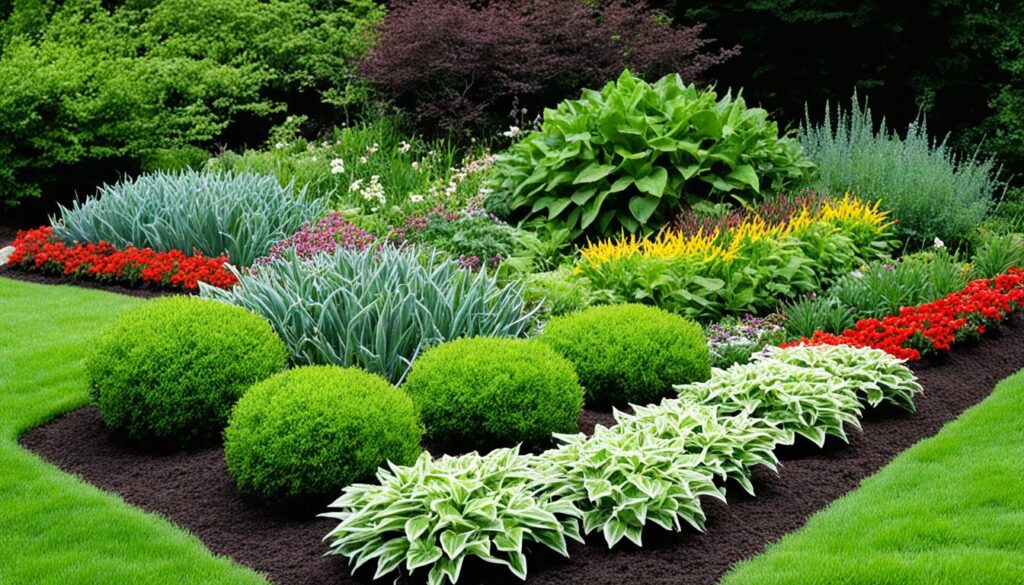
Using Insect Barriers and Covers
Organic pest control often uses physical barriers. Row covers and insect netting are great for keeping pests away. They let air, light, and water to your plants while keeping pests out. Knowing how to use these barriers can help protect your garden from pests.
Row Covers and Insect Netting
Row covers and insect netting protect many crops, from leafy greens to vegetables. These materials create a barrier that stops pests like aphids and beetles. They’re easy to put up and stay in place all season, giving your plants constant protection.
Timing and Maintenance
- Put row covers and insect netting on before pests become a problem to stop them early.
- Make sure they fit well to keep pests out.
- Check the barriers often for any damage and fix or replace them as needed.
- Take them off during flowering to let pollinators in, then put them back on to protect the plants.
Using these organic barriers in your garden means you can have a pest-free harvest. It also helps keep your garden healthy and balanced.
Organic Pest Control Methods
When basic steps don’t work to keep pests away, it’s time for more action. Luckily, there are organic ways to control pests that are good for the planet. You can try manual removal, trapping, or homemade organic sprays to protect your garden without using harsh chemicals.
Manual Removal and Trapping
For some pests, the best solution is to remove them by hand. Check your plants closely and pick off aphids, leaf miners, or slugs. You can also make natural traps, like jars filled with a sweet liquid to catch fruit flies or other insects.
Homemade Organic Sprays
If removing pests by hand isn’t possible, think about making your own organic sprays. You can use things like garlic, soap, and oils to make sprays that keep pests away. These homemade organic pesticides are cheaper and better for the environment than store-bought ones.
| Pest | Homemade Organic Spray |
|---|---|
| Aphids | Garlic-based spray |
| Spider mites | Neem oil spray |
| Caterpillars | Bacillus thuringiensis (Bt) spray |
Using natural pest traps and homemade organic sprays can help you manage pests. This way, you protect your health, the environment, and the good insects that help your garden.
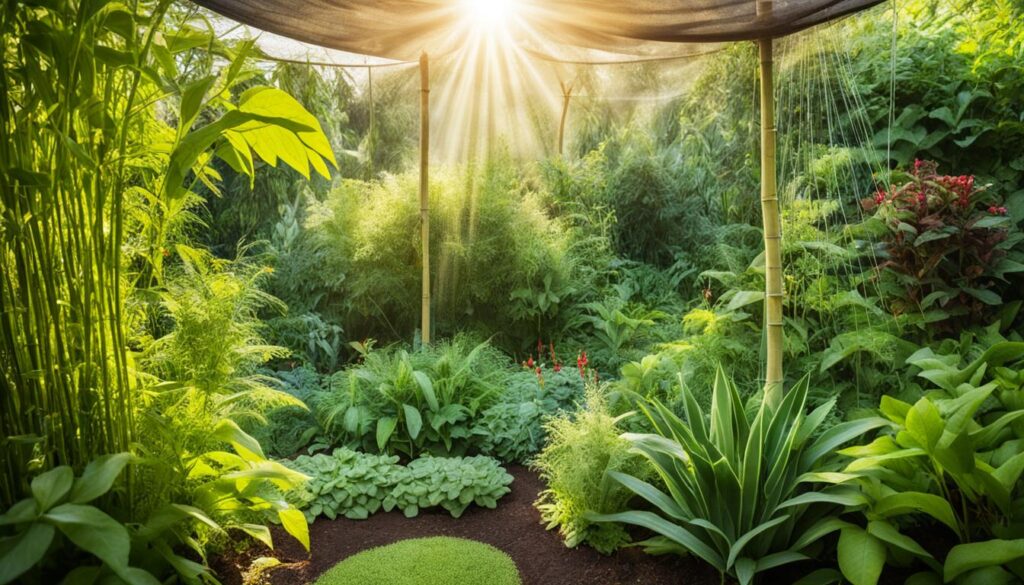
Encouraging Natural Predators
You can also attract snakes, lizards, birds, and bats to your garden to fight pests. These animals eat many insects and small pests. By giving them homes and food, you can bring them to your garden.
Snakes and Other Reptiles
Snakes and reptiles like lizards are great at controlling pests. They eat many insects and small animals that bother your garden. To attract them, add rocks, logs, or thick plants for hiding and sunning.
Birds and Bats
Birds and bats are also good at fighting garden pests. Birds like swallows and wrens eat lots of insects. Bats eat moths and mosquitoes at night. Build birdhouses and bat boxes to give them a place to live. Plant flowers that they like to eat.
By encouraging natural pest predators, your garden will be a balanced place. This way, you control pests naturally and support many kinds of wildlife. It’s good for your garden and the animals.
| Predator | Prey | Benefits |
|---|---|---|
| Snakes | Insects, rodents, small animals | Effective natural pest control, help maintain balanced ecosystem |
| Lizards | Insects, spiders, small invertebrates | Consume a variety of garden pests, contribute to biodiversity |
| Birds | Insects, caterpillars, small rodents | Reduce populations of harmful pests, provide natural pest management |
| Bats | Moths, mosquitoes, other night-flying insects | Control populations of nocturnal pests, help maintain ecological balance |
“Encouraging natural predators in the garden is a sustainable and effective way to manage pests organically. These vertebrate wildlife play a vital role in maintaining a healthy, balanced ecosystem.”
Organic Pest Control
In the world of sustainable gardening, organic pest management is key to keeping your garden healthy. It uses nature’s power to keep pests away without harsh chemicals. This approach protects your plants and helps pollinators and wildlife too.
Prevention is at the core of organic pest control. Healthy soil, less disturbance, and proper watering and cleaning keep pests away. Attracting beneficial insects, like lacewings and ladybugs, also helps by eating garden pests.
Using companion planting and crop rotation is also effective. These methods break up pest life cycles and make your garden strong against pests. Adding things like row covers and netting gives extra protection.
| Organic Pest Control Method | Description |
|---|---|
| Manual Removal and Trapping | Removing pests by hand or with non-toxic traps is a good way to control them. |
| Homemade Organic Sprays | Using things like essential oils and garlic can fight pests without harming the planet. |
| Encouraging Natural Predators | Letting snakes, birds, and bats in your garden helps control pests. |
Choosing organic pest control methods means your garden stays healthy and works with nature. This way, you protect your plants and keep the ecosystem balanced. Your garden will be a beautiful place for years to come.
“The ultimate goal of organic pest management is to create a healthy, balanced ecosystem that is naturally resistant to pests and disease.”
Integrating Biological Controls
Organic pest control can be powerful and kind to the planet. Using beneficial nematodes and Bacillus thuringiensis (Bt) can help. These tools work well with other organic methods to keep your garden healthy and free of pests.
Beneficial Nematodes
Beneficial nematodes are tiny roundworms that fight pests like grubs and fleas in the soil. They move into the soil and find and kill the young pests before they can harm your plants. Adding beneficial nematodes to your pest control plan gives your garden long-term protection against underground pests.
Bacillus thuringiensis (Bt)
Bacillus thuringiensis, or Bt, is another great organic biological control. It targets caterpillars and other pests that eat leaves. When these pests eat Bt, it harms their stomachs, stops them from eating, and eventually kills them. Bt is safe for good insects like bees, making it a good choice for your garden.
Using beneficial nematodes and Bacillus thuringiensis in your garden helps you fight pests in a green way. This approach keeps your garden healthy and safe from harmful chemicals.
“Biological controls like beneficial nematodes and Bt are a game-changer for organic gardeners. They provide targeted, eco-friendly solutions that work in harmony with nature to keep pests at bay.”
Monitoring and Early Intervention
Being alert and quick to act is key to keeping pests away from your garden naturally. Check your plants often and act fast if you see early pest detection. This way, small problems don’t turn into big ones. Using organic pest management strategies helps keep your garden healthy without harsh chemicals.
Begin by checking your plants every week for pests or damage. Know what pest you’re facing to pick the best natural solution. Whether it’s aphids, caterpillars, or beetles, there are many natural ways to fight them.
- Use a magnifying glass or hand lens to closely examine leaves, stems, and flowers for signs of pest activity.
- Keep a pest identification guide on hand to help you recognize common garden pests.
- Take clear photos of any unfamiliar insects or damage to consult with local extension services or online resources.
After spotting the pest, act fast with the right organic pest management strategies. This could mean removing pests by hand, using homemade sprays, or adding beneficial insects. The quicker you act, the better you can control the problem and stop it from spreading.
“Early detection and a proactive approach are essential for maintaining a healthy, pest-free garden. By staying vigilant and responding quickly, you can enjoy the benefits of a thriving, organic oasis.”
Remember, the secret to organic pest control is being proactive. With regular checks and quick action, you can have a garden that grows well naturally.
Conclusion
Your journey into organic pest control has shown you a green way to keep your garden healthy. By focusing on prevention and using natural methods, you can keep pests away safely. This approach protects your health and the environment too.
Using this approach might take some effort and trying different things. But, the benefits of a healthy garden are huge. You’ve discovered how to make soil rich in nutrients and use plants to keep pests away. This supports a wide variety of life in your garden.
Keep up with your organic gardening by always being alert and trying new things. Celebrate your successes, big or small. With a focus on organic gardening and sustainable pest management, you can make a garden that’s good for you and the planet.
FAQ
What are the benefits of using organic pest control methods?
Organic pest control is good for your garden and the planet. It uses no synthetic pesticides, keeping people and the environment safe.
How can I build a healthy, pest-resistant garden?
Start by making your soil rich with compost, mulch, and natural fertilizers. This makes plants strong against pests. Keep your soil healthy by removing weeds and watering plants right.
How can I attract beneficial insects to my garden?
Plant flowers like dill and parsley to draw in helpful bugs. These insects eat pests that bother your garden.
What are some effective companion planting and crop rotation strategies for pest control?
Plant marigolds with broccoli to keep pests away. Changing what you grow each year stops pests from spreading.
How can I use physical barriers to keep pests out of my garden?
Use row covers and insect netting to block pests. Make sure to put them up at the right time and take care of them.
What are some organic pest control methods I can use in my garden?
You can catch pests like aphids or use sprays made from garlic and soap. These methods are safe and effective.
How can I encourage natural predators to help control pests in my garden?
Make your garden a home for snakes, lizards, and birds. They eat pests and help keep your garden healthy.
What are some biological control options for organic pest management?
Use beneficial nematodes and Bacillus thuringiensis (Bt) to fight pests. These natural agents target pests safely and effectively.
How can I stay on top of pest problems in my garden?
Check your garden often and act fast if you see pests. Knowing what pests you have and using organic controls quickly can stop big problems.
Source Links
- https://learn.eartheasy.com/guides/natural-garden-pest-control/ – Natural Garden Pest Control
- https://www.almanac.com/how-we-keep-pests-out-garden – How We Keep Pests Out of the Garden (Naturally!)
- https://www.gardenary.com/blog/organic-ways-to-treat-pests-in-a-vegetable-garden – Organic Ways to Treat Pests in a Vegetable Garden • Gardenary
- 10 Must-Have Blooms for Your 2025 Garden
- The Health Advantages of Gardening You Need to Know
- How to Create a Small Vegetable Garden Layout Plan: A Beginner’s Guide
- DIY Garden Projects for Small Spaces: Upcycling Ideas to Maximize Your Garden
- Watering Techniques for Small Gardens: Ensuring Your Plants Thrive
- Small Border Plants for Landscaping: Adding Beauty and Functionality to Your Garden
- Year-Round Small Space Gardening: Seasonal Planting Tips for Maximum Harvest
- Essential Tools for Small-Space Gardening: What You Really Need
- The Ultimate Guide to Container Vegetables: What to Grow in Small Spaces
- Budget-Friendly Gardening: How to Create a Thriving Garden on a Tight Budget
- How to Optimize Sunlight in Small Gardens: Tips for Better Plant Growth
- DIY Vertical Planters: Creative Ideas for Small Space Gardening
- Companion Planting for Small Vegetable Gardens: Boost Growth and Deter Pests
- Container Gardening Essentials: Choosing the Right Pots, Soil, and Plants
- Vertical Gardening Techniques: Maximizing Your Small Space with Climbers and Vines
- How to Build a Raised Bed Garden in a Small Backyard: Step-by-Step Guide
- The Best Vegetables for Small-Space Gardens: High-Yield Varieties You Need to Grow
- Smart Vegetable Garden Layouts for Small Spaces: Maximizing Your Green Thumb in Compact Areas
- 40. Best Practices for Managing a Sustainable Garden Year-Round
- Building a Wildlife Pond for Biodiversity
- Advanced Techniques in Sustainable Gardening
- How to Create a No-Till Garden
- The Mental Health Benefits of Gardening
- Using Technology to Enhance Sustainable Gardening
- Getting Certified Organic: Steps and Benefits
